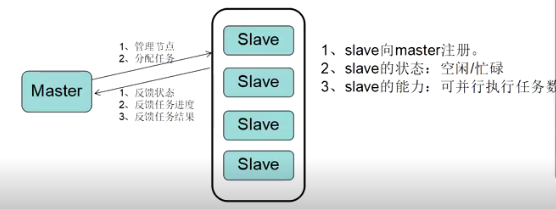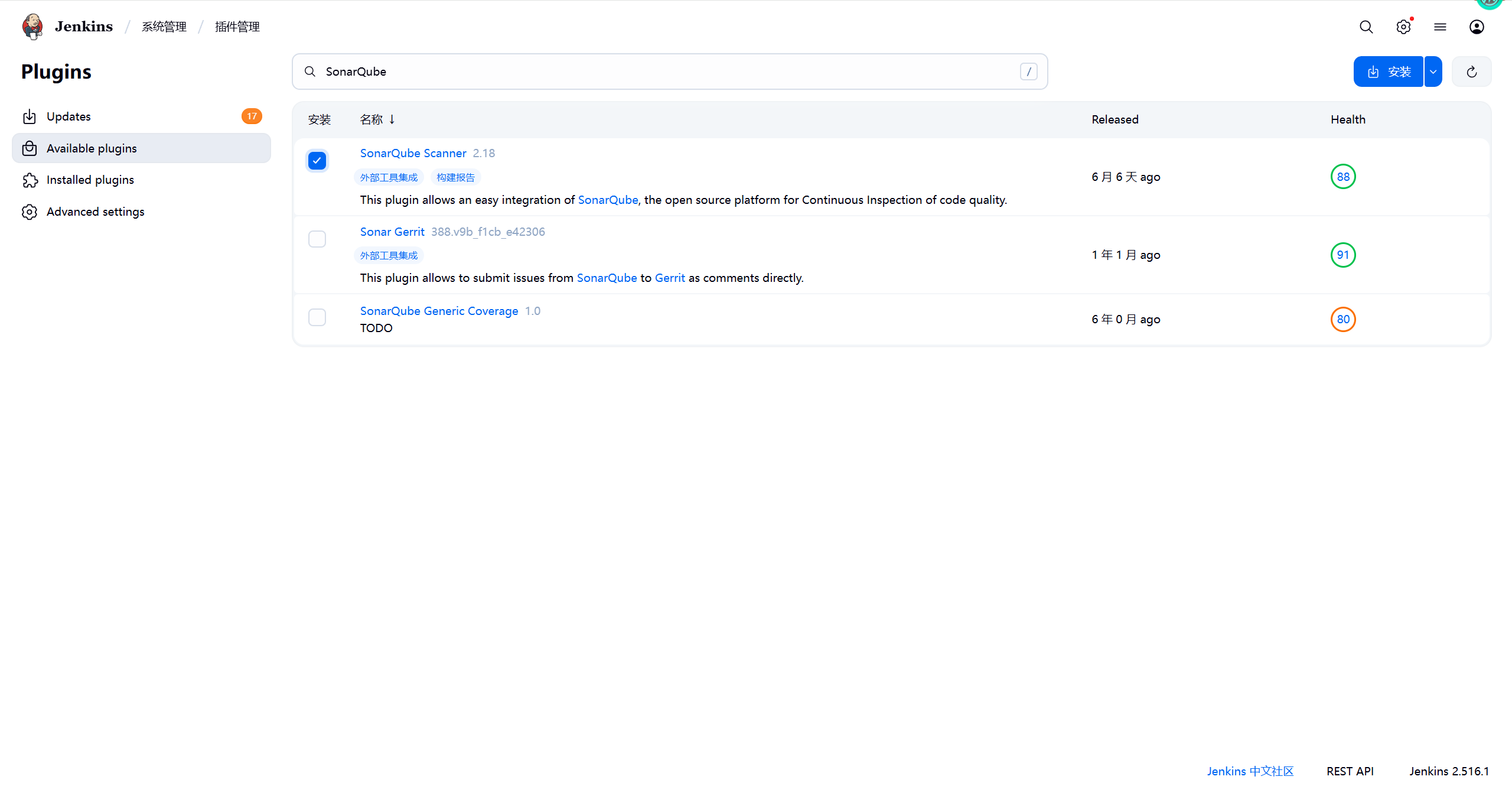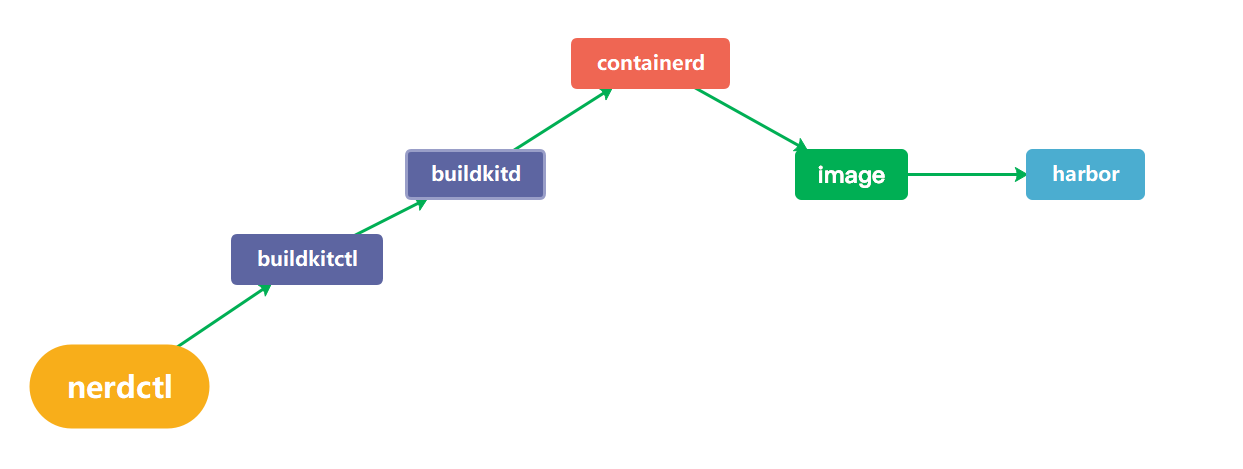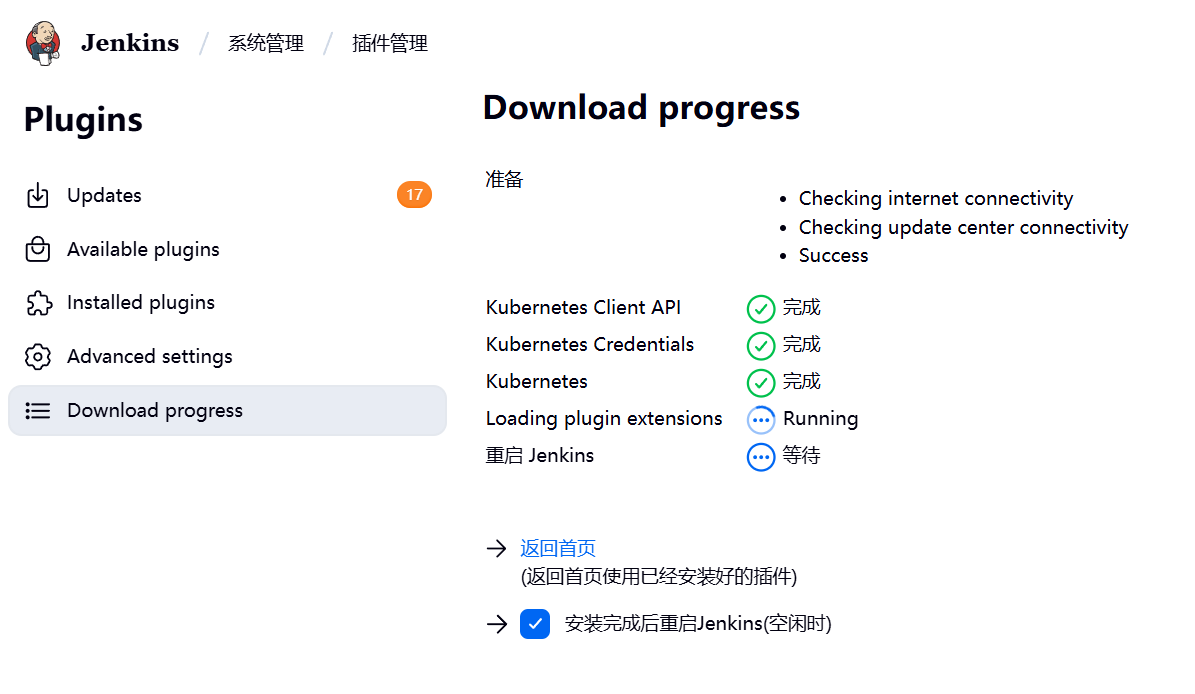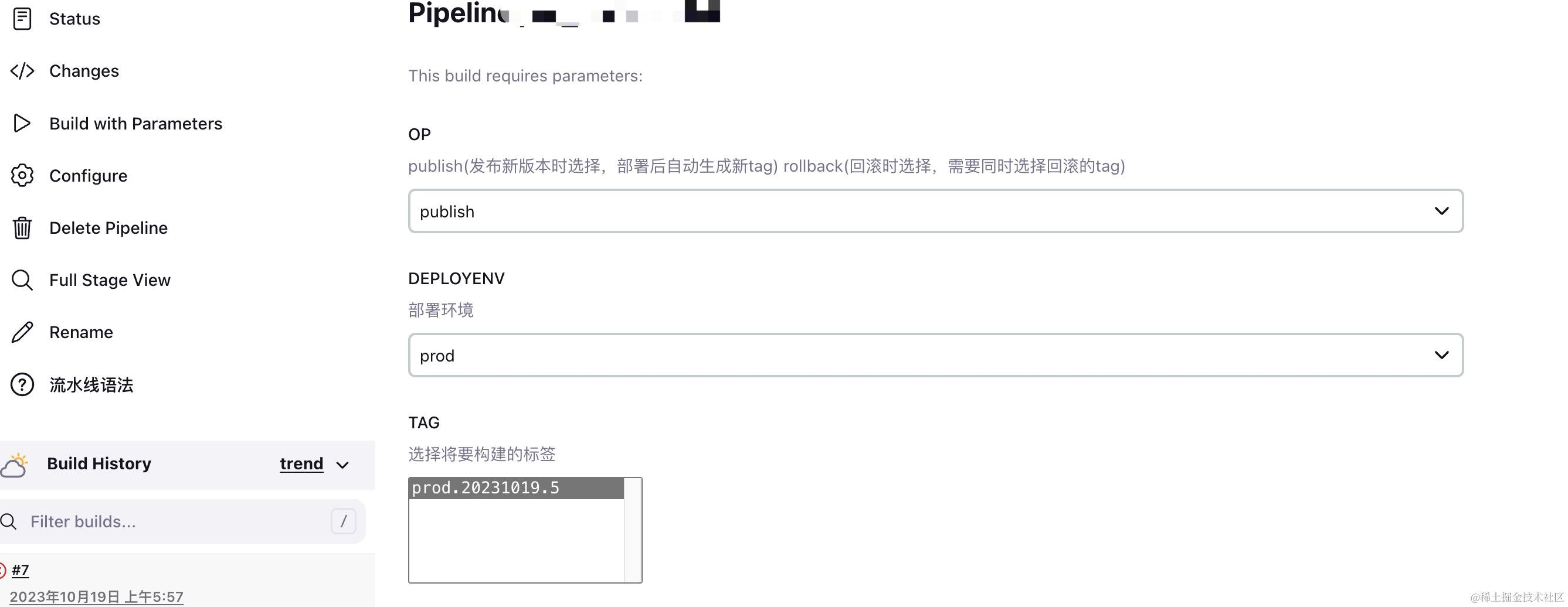搜索到
86
篇与
的结果
-
 jenkins添加节点-slave集群配置 一、Jenkins的Master/Slave机制Jenkins采用Master/Slave架构。Master/Slave相当于Server和agent的概念,Master提供web接口让用户来管理Job和Slave,Job可以运行在Master本机或者被分配到Slave上运行。一个Master可以关联多个Slave用来为不同的Job或相同的Job的不同配置来服务。 Jenkins的Master/Slave机制除了可以并发的执行构建任务,加速构建以外。还可以用于分布式自动化测试,当自动化测试代码非常多或者是需要在多个浏览器上并行的时候,可以把测试代码划分到不同节点上运行,从而加速自动化测试的执行。二、集群角色功能**Master:**Jenkins服务器。主要是处理调度构建作业,把构建分发到Slave节点实际执行,监视Slave节点的状态。当然,也并不是说Master节点不能跑任务。构建结果和构建产物最后还是传回到Master节点,比如说在jenkins工作目录下面的workspace内的内容,在Master节点照样是有一份的。 **Slave:**执行机(奴隶机)。执行Master分配的任务,并返回任务的进度和结果。Jenkins Master/Slave的搭建需要至少两台机器,一台Master节点,一台Slave节点(实际生产中会有多个Slave节点)。三、搭建步骤Master不需要主动去建立,安装Jenkins,在登录到主界面时,这台电脑就已经默认为master。 选择“Manage Jenkins”->“Manage Nodes and Clouds”,可以看到Master节点相关信息:四、为Jenkins添加Slave Node 4.1开启tcp代理端口jenkins web代理是指slave通过jenkins服务端提供的一个tcp端口,与jenkins服务端建立连接,docker版的jenkins默认开启web tcp代理,端口为50000,而自己手动制作的jenkins容器或者在物理机环境部署的jenkins,都需要手动开启web代理端口,如果不开启,slave无法通过web代理的方式与jenkins建立连接。 jenkins web代理的tcp端口不是通过命令启动的而是通过在全局安全设置中配置的,配置成功后会在系统上运行一个指定的端口4.2添加节点信息在Jenkins界面选择“Manage Jenkins”->“Manage Nodes and Clouds”->“New Node配置Agent信息Name:Slave机器的名字 Description:描述 ,不重要 随意填 Number of excutors:允许在这个节点上并发执行任务的数量,即同时可以下发多少个Job到Slave上执行,一般设置为 cpu 支持的线程数。[注:Master Node也可以通过此参数配置Master是否也执行构建任务、还是仅作为Jenkins调度节点] Remote root directory:用来放工程的文件夹,jenkins master上设置的下载的代码会放到这个工作目录下。 Lables:标签,用于实现后续Job调度策略,根据Jobs配置的Label选择Salve Node Usage:支持两种模式“Use this Node as much as possible”、“Only build Jobs with Label expressiong matching this Node”。选择“Only build Jobs with Label expressiong matching this Node”, 添加完毕后,在Jenkins主界面,可以看到新添加的Slave Node,但是红叉表示此时的Slave并未与Master建立起联系。4.3slave节点配置安装jdk#dnf -y install java-17-openjdk root@k8s-02:~# java -version openjdk version "17.0.16" 2025-07-15 LTS OpenJDK Runtime Environment Corretto-17.0.16.8.1 (build 17.0.16+8-LTS) OpenJDK 64-Bit Server VM Corretto-17.0.16.8.1 (build 17.0.16+8-LTS, mixed mode, sharing) 安装agent 点击节点信息,根据控制台提示执行安装agent命令root@k8s-02:~# curl -sO http://192.168.30.180:31530/jnlpJars/agent.jar root@k8s-02:~# java -jar agent.jar -url http://192.168.30.180:31530/ -secret 6e87c37900dfbdcff98099f6681f7b195a141de1cacb157679efc98f8fec2644 -name "k8s-02" -webSocket -workDir "/opt/jenkins" Aug 03, 2025 12:52:47 PM org.jenkinsci.remoting.engine.WorkDirManager initializeWorkDir INFO: Using /opt/jenkins/remoting as a remoting work directory Aug 03, 2025 12:52:47 PM org.jenkinsci.remoting.engine.WorkDirManager setupLogging INFO: Both error and output logs will be printed to /opt/jenkins/remoting Aug 03, 2025 12:52:47 PM hudson.remoting.Launcher createEngine INFO: Setting up agent: k8s-02 Aug 03, 2025 12:52:47 PM hudson.remoting.Engine startEngine INFO: Using Remoting version: 3309.v27b_9314fd1a_4 Aug 03, 2025 12:52:47 PM org.jenkinsci.remoting.engine.WorkDirManager initializeWorkDir INFO: Using /opt/jenkins/remoting as a remoting work directory Aug 03, 2025 12:52:47 PM hudson.remoting.Launcher$CuiListener status INFO: WebSocket connection open Aug 03, 2025 12:52:47 PM hudson.remoting.Launcher$CuiListener status INFO: Connected4.4查看agent状态指定Node调度策略 创建Job的页面,“General”下勾选“Restric where this project can be run”,填写Label Expression。
jenkins添加节点-slave集群配置 一、Jenkins的Master/Slave机制Jenkins采用Master/Slave架构。Master/Slave相当于Server和agent的概念,Master提供web接口让用户来管理Job和Slave,Job可以运行在Master本机或者被分配到Slave上运行。一个Master可以关联多个Slave用来为不同的Job或相同的Job的不同配置来服务。 Jenkins的Master/Slave机制除了可以并发的执行构建任务,加速构建以外。还可以用于分布式自动化测试,当自动化测试代码非常多或者是需要在多个浏览器上并行的时候,可以把测试代码划分到不同节点上运行,从而加速自动化测试的执行。二、集群角色功能**Master:**Jenkins服务器。主要是处理调度构建作业,把构建分发到Slave节点实际执行,监视Slave节点的状态。当然,也并不是说Master节点不能跑任务。构建结果和构建产物最后还是传回到Master节点,比如说在jenkins工作目录下面的workspace内的内容,在Master节点照样是有一份的。 **Slave:**执行机(奴隶机)。执行Master分配的任务,并返回任务的进度和结果。Jenkins Master/Slave的搭建需要至少两台机器,一台Master节点,一台Slave节点(实际生产中会有多个Slave节点)。三、搭建步骤Master不需要主动去建立,安装Jenkins,在登录到主界面时,这台电脑就已经默认为master。 选择“Manage Jenkins”->“Manage Nodes and Clouds”,可以看到Master节点相关信息:四、为Jenkins添加Slave Node 4.1开启tcp代理端口jenkins web代理是指slave通过jenkins服务端提供的一个tcp端口,与jenkins服务端建立连接,docker版的jenkins默认开启web tcp代理,端口为50000,而自己手动制作的jenkins容器或者在物理机环境部署的jenkins,都需要手动开启web代理端口,如果不开启,slave无法通过web代理的方式与jenkins建立连接。 jenkins web代理的tcp端口不是通过命令启动的而是通过在全局安全设置中配置的,配置成功后会在系统上运行一个指定的端口4.2添加节点信息在Jenkins界面选择“Manage Jenkins”->“Manage Nodes and Clouds”->“New Node配置Agent信息Name:Slave机器的名字 Description:描述 ,不重要 随意填 Number of excutors:允许在这个节点上并发执行任务的数量,即同时可以下发多少个Job到Slave上执行,一般设置为 cpu 支持的线程数。[注:Master Node也可以通过此参数配置Master是否也执行构建任务、还是仅作为Jenkins调度节点] Remote root directory:用来放工程的文件夹,jenkins master上设置的下载的代码会放到这个工作目录下。 Lables:标签,用于实现后续Job调度策略,根据Jobs配置的Label选择Salve Node Usage:支持两种模式“Use this Node as much as possible”、“Only build Jobs with Label expressiong matching this Node”。选择“Only build Jobs with Label expressiong matching this Node”, 添加完毕后,在Jenkins主界面,可以看到新添加的Slave Node,但是红叉表示此时的Slave并未与Master建立起联系。4.3slave节点配置安装jdk#dnf -y install java-17-openjdk root@k8s-02:~# java -version openjdk version "17.0.16" 2025-07-15 LTS OpenJDK Runtime Environment Corretto-17.0.16.8.1 (build 17.0.16+8-LTS) OpenJDK 64-Bit Server VM Corretto-17.0.16.8.1 (build 17.0.16+8-LTS, mixed mode, sharing) 安装agent 点击节点信息,根据控制台提示执行安装agent命令root@k8s-02:~# curl -sO http://192.168.30.180:31530/jnlpJars/agent.jar root@k8s-02:~# java -jar agent.jar -url http://192.168.30.180:31530/ -secret 6e87c37900dfbdcff98099f6681f7b195a141de1cacb157679efc98f8fec2644 -name "k8s-02" -webSocket -workDir "/opt/jenkins" Aug 03, 2025 12:52:47 PM org.jenkinsci.remoting.engine.WorkDirManager initializeWorkDir INFO: Using /opt/jenkins/remoting as a remoting work directory Aug 03, 2025 12:52:47 PM org.jenkinsci.remoting.engine.WorkDirManager setupLogging INFO: Both error and output logs will be printed to /opt/jenkins/remoting Aug 03, 2025 12:52:47 PM hudson.remoting.Launcher createEngine INFO: Setting up agent: k8s-02 Aug 03, 2025 12:52:47 PM hudson.remoting.Engine startEngine INFO: Using Remoting version: 3309.v27b_9314fd1a_4 Aug 03, 2025 12:52:47 PM org.jenkinsci.remoting.engine.WorkDirManager initializeWorkDir INFO: Using /opt/jenkins/remoting as a remoting work directory Aug 03, 2025 12:52:47 PM hudson.remoting.Launcher$CuiListener status INFO: WebSocket connection open Aug 03, 2025 12:52:47 PM hudson.remoting.Launcher$CuiListener status INFO: Connected4.4查看agent状态指定Node调度策略 创建Job的页面,“General”下勾选“Restric where this project can be run”,填写Label Expression。 -
 jenkins与SonarQube连接 一、jenkins安装插件 1.1下载SonarQube插件进入Jenkins的系统管理->插件管理->可选插件,搜索框输入sonarqube,安装重启。1.2启用SonarQubeJenkins的系统管理->系统配置,添加SonarQube服务。二、SonarQube配置 2.1禁用审查结果上传到SCM功能2.2生成token添加jenkin用户 token:squ_4bc173eb520dd35c176104baa1b899a992e88c88三、jenkins配置 3.1添加令牌Jenkins的系统管理->系统配置->添加token类型切换成Secret text,粘贴token,点击添加。选上刚刚添加的令牌凭证,点击应用保存。3.2SonarQube Scanner 安装进入Jenkins的系统管理->全局工具配置,下滑找到图片里的地方,点击新增SonarQube Scanner,我们选择自动安装并选择最新的版本。四、非流水线项目添加代码审查 4.1添加构建步骤编辑之前的自由风格构建的demo项目,在构建阶段新增步骤。analysis properties参数如下# 项目名称id,全局唯一 sonar.projectKey=sprint_boot_demo # 项目名称 sonar.projectName=sprint_boot_demo sonar.projectVersion=1.0 # 扫描路径,当前项目根目录 sonar.sources=./src # 排除目录 sonar.exclusions=**/test/**,**/target/** # jdk版本 sonar.java.source=1.17 sonar.java.target=1.17 # 字符编码 sonar.sourceEncoding=UTF-8 # binaries路径 sonar.java.binaries=target/classes4.2构建并查看结果jenkins点击立即构建,查看构建结果查看SonarQube扫描结果五、流水线项目添加代码审查 5.1创建sonar-project.properties文件项目根目录下,创建sonar-project.properties文件,内容如下# 项目名称id,全局唯一 sonar.projectKey=sprint_boot_demo # 项目名称 sonar.projectName=sprint_boot_demo sonar.projectVersion=1.0 # 扫描路径,当前项目根目录 sonar.sources=./src # 排除目录 sonar.exclusions=**/test/**,**/target/** # jdk版本 sonar.java.source=1.17 sonar.java.target=1.17 # 字符编码 sonar.sourceEncoding=UTF-8 # binaries路径 sonar.java.binaries=target/classes5.2修改Jenkinsfile加入SonarQube代码审查阶段pipeline { agent any stages { stage('拉取代码') { steps { echo '开始拉取代码' checkout([$class: 'GitSCM', branches: [[name: '*/master']], userRemoteConfigs: [[url: 'https://gitee.com/axzys/sprint_boot_demo.git']]]) echo '拉取代码完成' } } stage('打包编译') { steps { echo '开始打包编译' sh 'mvn clean package' echo '打包编译完成' } } stage('代码审查') { steps { echo '开始代码审查' script { // 引入SonarQube scanner,名称与jenkins 全局工具SonarQube Scanner的name保持一致 def scannerHome = tool 'SonarQube' // 引入SonarQube Server,名称与jenkins 系统配置SonarQube servers的name保持一致 withSonarQubeEnv('SonarQube') { sh "${scannerHome}/bin/sonar-scanner" } } echo '代码审查完成' } } stage('部署项目') { steps { echo '开始部署项目' echo '部署项目完成' } } } } 5.3构建测试
jenkins与SonarQube连接 一、jenkins安装插件 1.1下载SonarQube插件进入Jenkins的系统管理->插件管理->可选插件,搜索框输入sonarqube,安装重启。1.2启用SonarQubeJenkins的系统管理->系统配置,添加SonarQube服务。二、SonarQube配置 2.1禁用审查结果上传到SCM功能2.2生成token添加jenkin用户 token:squ_4bc173eb520dd35c176104baa1b899a992e88c88三、jenkins配置 3.1添加令牌Jenkins的系统管理->系统配置->添加token类型切换成Secret text,粘贴token,点击添加。选上刚刚添加的令牌凭证,点击应用保存。3.2SonarQube Scanner 安装进入Jenkins的系统管理->全局工具配置,下滑找到图片里的地方,点击新增SonarQube Scanner,我们选择自动安装并选择最新的版本。四、非流水线项目添加代码审查 4.1添加构建步骤编辑之前的自由风格构建的demo项目,在构建阶段新增步骤。analysis properties参数如下# 项目名称id,全局唯一 sonar.projectKey=sprint_boot_demo # 项目名称 sonar.projectName=sprint_boot_demo sonar.projectVersion=1.0 # 扫描路径,当前项目根目录 sonar.sources=./src # 排除目录 sonar.exclusions=**/test/**,**/target/** # jdk版本 sonar.java.source=1.17 sonar.java.target=1.17 # 字符编码 sonar.sourceEncoding=UTF-8 # binaries路径 sonar.java.binaries=target/classes4.2构建并查看结果jenkins点击立即构建,查看构建结果查看SonarQube扫描结果五、流水线项目添加代码审查 5.1创建sonar-project.properties文件项目根目录下,创建sonar-project.properties文件,内容如下# 项目名称id,全局唯一 sonar.projectKey=sprint_boot_demo # 项目名称 sonar.projectName=sprint_boot_demo sonar.projectVersion=1.0 # 扫描路径,当前项目根目录 sonar.sources=./src # 排除目录 sonar.exclusions=**/test/**,**/target/** # jdk版本 sonar.java.source=1.17 sonar.java.target=1.17 # 字符编码 sonar.sourceEncoding=UTF-8 # binaries路径 sonar.java.binaries=target/classes5.2修改Jenkinsfile加入SonarQube代码审查阶段pipeline { agent any stages { stage('拉取代码') { steps { echo '开始拉取代码' checkout([$class: 'GitSCM', branches: [[name: '*/master']], userRemoteConfigs: [[url: 'https://gitee.com/axzys/sprint_boot_demo.git']]]) echo '拉取代码完成' } } stage('打包编译') { steps { echo '开始打包编译' sh 'mvn clean package' echo '打包编译完成' } } stage('代码审查') { steps { echo '开始代码审查' script { // 引入SonarQube scanner,名称与jenkins 全局工具SonarQube Scanner的name保持一致 def scannerHome = tool 'SonarQube' // 引入SonarQube Server,名称与jenkins 系统配置SonarQube servers的name保持一致 withSonarQubeEnv('SonarQube') { sh "${scannerHome}/bin/sonar-scanner" } } echo '代码审查完成' } } stage('部署项目') { steps { echo '开始部署项目' echo '部署项目完成' } } } } 5.3构建测试 -
 buildctl和nerdctl 安装配置 一、安装与使用nerdctlcontainerd虽然可直接提供给终端用户直接使用,也提供了命令行工具(ctr),但并不是很友好,所以nerdctl应运而生,它也是containerd的命令行工具,支持docker cli关于容器生命周期管理的所有命令,并且支持docker compose (nerdctl compose up)1.1安装nerdctl下载地址:https://github.com/containerd/nerdctl/releases# 下载 [root@k8s-master ~]# wget https://github.com/containerd/nerdctl/releases/download/v2.1.2/nerdctl-2.1.2-linux-amd64.tar.gz # 解压 [root@k8s-master ~]# tar -zxvf nerdctl-2.1.2-linux-amd64.tar.gz nerdctl containerd-rootless-setuptool.sh containerd-rootless.sh # 复制文件 [root@k8s-master ~]# mv nerdctl /usr/bin/ # 配置 nerdctl 参数自动补齐 [root@k8s-master ~]# echo 'source <(nerdctl completion bash)' >> /etc/profile [root@k8s-master ~]# source /etc/profile # 验证 [root@k8s-master ~]# nerdctl -v nerdctl version 2.1.21.2命名空间这个和K8s的名字空间不是一回事,其中default就是containerd的默认名字空间,http://k8s.io是K8s的名字空间root@k8s-03:~/bin# nerdctl ns ls NAME CONTAINERS IMAGES VOLUMES LABELS buildkit 0 0 0 buildkit_history 0 0 0 default 0 1 0 k8s.io 70 66 0 # 创建命名空间 [root@k8s-master ~]# nerdctl ns create test # 删除命名空间 [root@k8s-master ~]# nerdctl ns remove test test # 查看名称空间详情 [root@k8s-master ~]# nerdctl ns inspect k8s.io [ { "Name": "k8s.io", "Labels": null } ]1.3镜像root@k8s-03:~/bin# nerdctl -n k8s.io images REPOSITORY TAG IMAGE ID CREATED PLATFORM SIZE BLOB SIZE registry.cn-guangzhou.aliyuncs.com/xingcangku/jenkins-cangku <none> b3e519ae85d0 4 hours ago linux/amd64 406.2MB 179.1MB <none> <none> b3e519ae85d0 4 hours ago linux/amd64 406.2MB 179.1MB registry.cn-guangzhou.aliyuncs.com/xingcangku/jenkins-cangku v1 b3e519ae85d0 4 hours ago linux/amd64 406.2MB 179.1MB registry.cn-guangzhou.aliyuncs.com/xingcangku/harbor-registryctl <none> a13c1fd0b23e 22 hours ago linux/amd64 163.5MB 67.74MB <none> <none> a13c1fd0b23e 22 hours ago linux/amd64 163.5MB 67.74MB registry.cn-guangzhou.aliyuncs.com/xingcangku/harbor-registryctl v2.13.0 a13c1fd0b23e 22 hours ago linux/amd64 163.5MB 67.74MB registry.cn-guangzhou.aliyuncs.com/xingcangku/redis-photon <none> cb5883e8415a 22 hours ago linux/amd64 171.5MB 61MB <none> <none> cb5883e8415a 22 hours ago linux/amd64 171.5MB 61MB registry.cn-guangzhou.aliyuncs.com/xingcangku/redis-photon v2.13.0 cb5883e8415a 22 hours ago linux/amd64 171.5MB 61MB registry.cn-guangzhou.aliyuncs.com/xingcangku/harbor-core <none> d75212166cdb 22 hours ago linux/amd64 202.4MB 63.85MB <none> <none> d75212166cdb 22 hours ago linux/amd64 202.4MB 63.85MB registry.cn-guangzhou.aliyuncs.com/xingcangku/harbor-core v2.13.0 d75212166cdb 22 hours ago linux/amd64 202.4MB 63.85MB registry.cn-guangzhou.aliyuncs.com/xingcangku/registry-photon <none> b9139a9005f9 22 hours ago linux/amd64 87.67MB 33.14MB <none> <none> b9139a9005f9 22 hours ago linux/amd64 87.67MB 33.14MB registry.cn-guangzhou.aliyuncs.com/xingcangku/registry-photon v2.13.0 b9139a9005f9 22 hours ago linux/amd64 87.67MB 33.14MB registry.cn-guangzhou.aliyuncs.com/xingcangku/harbor-portal <none> 19712b3eeee5 22 hours ago linux/amd64 165.2MB 53.6MB <none> <none> 19712b3eeee5 22 hours ago linux/amd64 165.2MB 53.6MB registry.cn-guangzhou.aliyuncs.com/xingcangku/harbor-portal v2.13.0 19712b3eeee5 22 hours ago linux/amd64 165.2MB 53.6MB registry.cn-guangzhou.aliyuncs.com/xingcangku/gitlab-gitlab-ce-16.11.1-ce.0 <none> decbed64a538 2 days ago linux/amd64 3.109GB 1.253GB <none> <none> decbed64a538 2 days ago linux/amd64 3.109GB 1.253GB registry.cn-guangzhou.aliyuncs.com/xingcangku/gitlab-gitlab-ce-16.11.1-ce.0 16.11.1-ce.0 decbed64a538 2 days ago linux/amd64 3.109GB 1.253GB registry.cn-guangzhou.aliyuncs.com/xingcangku/traefik <none> 39f367894114 2 days ago linux/amd64 225.8MB 58.3MB <none> <none> 39f367894114 2 days ago linux/amd64 225.8MB 58.3MB registry.cn-guangzhou.aliyuncs.com/xingcangku/traefik v3.0.0 39f367894114 2 days ago linux/amd64 225.8MB 58.3MB registry.cn-guangzhou.aliyuncs.com/xingcangku/kubernetesui-dashboard <none> e291095692ba 3 days ago linux/amd64 257.7MB 75.79MB <none> <none> e291095692ba 3 days ago linux/amd64 257.7MB 75.79MB registry.cn-guangzhou.aliyuncs.com/xingcangku/kubernetesui-dashboard v2.7.0 e291095692ba 3 days ago linux/amd64 257.7MB 75.79MB registry.cn-guangzhou.aliyuncs.com/xingcangku/kubernetesui-metrics-scraper <none> ca7729489386 3 days ago linux/amd64 43.82MB 19.74MB <none> <none> ca7729489386 3 days ago linux/amd64 43.82MB 19.74MB registry.cn-guangzhou.aliyuncs.com/xingcangku/kubernetesui-metrics-scraper v1.0.8 ca7729489386 3 days ago linux/amd64 43.82MB 19.74MB registry.cn-guangzhou.aliyuncs.com/xingcangku/bitnami-postgresql <none> 94485e7c7d1d 3 days ago linux/amd64 280.1MB 90.55MB <none> <none> 94485e7c7d1d 3 days ago linux/amd64 280.1MB 90.55MB registry.cn-guangzhou.aliyuncs.com/xingcangku/bitnami-postgresql 11.14.0-debian-10-r22 94485e7c7d1d 3 days ago linux/amd64 280.1MB 90.55MB registry.cn-guangzhou.aliyuncs.com/xingcangku/sonarqube-community <none> b5e625526868 3 days ago linux/amd64 1.24GB 957.4MB <none> <none> b5e625526868 3 days ago linux/amd64 1.24GB 957.4MB registry.cn-guangzhou.aliyuncs.com/xingcangku/sonarqube-community 25.5.0.107428-community b5e625526868 3 days ago linux/amd64 1.24GB 957.4MB registry.cn-guangzhou.aliyuncs.com/xingcangku/jenkins-jenkins-lts-jdk17 <none> bb363b39bef3 3 days ago linux/amd64 483.5MB 271.9MB <none> <none> bb363b39bef3 3 days ago linux/amd64 483.5MB 271.9MB registry.cn-guangzhou.aliyuncs.com/xingcangku/jenkins-jenkins-lts-jdk17 lts-jdk17 bb363b39bef3 3 days ago linux/amd64 483.5MB 271.9MB registry.cn-guangzhou.aliyuncs.com/xingcangku/trivy-adapter-photon <none> ad014f12e11c 3 days ago linux/amd64 383.3MB 126.1MB <none> <none> ad014f12e11c 3 days ago linux/amd64 383.3MB 126.1MB registry.cn-guangzhou.aliyuncs.com/xingcangku/trivy-adapter-photon v2.13.0 ad014f12e11c 3 days ago linux/amd64 383.3MB 126.1MB registry.cn-guangzhou.aliyuncs.com/xingcangku/harbor-db <none> dc08b59ada6d 3 days ago linux/amd64 285.4MB 108.1MB <none> <none> dc08b59ada6d 3 days ago linux/amd64 285.4MB 108.1MB registry.cn-guangzhou.aliyuncs.com/xingcangku/harbor-db v2.13.0 dc08b59ada6d 3 days ago linux/amd64 285.4MB 108.1MB registry.cn-guangzhou.aliyuncs.com/xingcangku/harbor-jobservice <none> 8ccc99b52f23 3 days ago linux/amd64 178.5MB 72.67MB <none> <none> 8ccc99b52f23 3 days ago linux/amd64 178.5MB 72.67MB registry.cn-guangzhou.aliyuncs.com/xingcangku/harbor-jobservice v2.13.0 8ccc99b52f23 3 days ago linux/amd64 178.5MB 72.67MB registry.cn-guangzhou.aliyuncs.com/xingcangku/nginx-photon <none> 87662c08516c 3 days ago linux/amd64 156.5MB 51.41MB <none> <none> 87662c08516c 3 days ago linux/amd64 156.5MB 51.41MB registry.cn-guangzhou.aliyuncs.com/xingcangku/nginx-photon v2.13.0 87662c08516c 3 days ago linux/amd64 156.5MB 51.41MB registry.cn-hangzhou.aliyuncs.com/google_containers/coredns <none> 90d3eeb2e210 3 days ago linux/amd64 53.61MB 16.19MB <none> <none> 90d3eeb2e210 3 days ago linux/amd64 53.61MB 16.19MB registry.cn-hangzhou.aliyuncs.com/google_containers/coredns v1.10.1 90d3eeb2e210 3 days ago linux/amd64 53.61MB 16.19MB registry.cn-guangzhou.aliyuncs.com/xingcangku/cccc <none> f3e2173b0e48 3 days ago linux/amd64 82.5MB 31.09MB <none> <none> f3e2173b0e48 3 days ago linux/amd64 82.5MB 31.09MB registry.cn-guangzhou.aliyuncs.com/xingcangku/cccc 0.25.5 f3e2173b0e48 3 days ago linux/amd64 82.5MB 31.09MB registry.cn-guangzhou.aliyuncs.com/xingcangku/ddd <none> 564119549dd9 3 days ago linux/amd64 10.73MB 4.755MB <none> <none> 564119549dd9 3 days ago linux/amd64 10.73MB 4.755MB registry.cn-guangzhou.aliyuncs.com/xingcangku/ddd 1.5.1 564119549dd9 3 days ago linux/amd64 10.73MB 4.755MB registry.cn-hangzhou.aliyuncs.com/google_containers/kube-proxy <none> c1fd57dc0883 3 days ago linux/amd64 75.16MB 23.91MB <none> <none> c1fd57dc0883 3 days ago linux/amd64 75.16MB 23.91MB registry.cn-hangzhou.aliyuncs.com/google_containers/kube-proxy v1.27.0 c1fd57dc0883 3 days ago linux/amd64 75.16MB 23.91MB registry.cn-guangzhou.aliyuncs.com/xingcangku/eeeee <none> 0d0658a57932 3 days ago linux/amd64 712.7kB 308.4kB <none> <none> 0d0658a57932 3 days ago linux/amd64 712.7kB 308.4kB registry.cn-guangzhou.aliyuncs.com/xingcangku/eeeee 3.8 0d0658a57932 3 days ago linux/amd64 712.7kB 308.4kB # 拉取镜像 [root@k8s-master ~]# nerdctl -n test pull nginx:alpine # 构建镜像 [root@k8s-master ~]# cat Dockerfile FROM debian RUN apt-get install -y --force-yes locales RUN echo "LC_ALL=\"zh_CN.UTF-8\"" >> /etc/default/locale RUN locale-gen "zh_CN.UTF-8" [root@k8s-master ~]# nerdctl -n test build -t abc.com/debian . # 上传镜像 [root@k8s-master ~]# nerdctl -n test push abc.com/debian # 导出镜像 [root@k8s-master ~]# nerdctl -n test save -o debian.tar abc.com/debian # 导入镜像 [root@k8s-master ~]# nerdctl -n test load -i debian.tar 1.4容器root@k8s-03:~/bin# nerdctl -n k8s.io ps CONTAINER ID IMAGE COMMAND CREATED STATUS PORTS NAMES 90fbd223a72f registry.cn-guangzhou.aliyuncs.com/xingcangku/jenkins-jenkins-lts-jdk17:lts-jdk17 "/usr/bin/tini -- /u…" 9 hours ago Up k8s://cicd/jenkins-7d65887794-s4vhr/jenkins 681d3d0f9346 registry.cn-guangzhou.aliyuncs.com/xingcangku/eeeee:3.8 "/pause" 9 hours ago Up k8s://cicd/jenkins-7d65887794-s4vhr cfb418a6f445 registry.cn-guangzhou.aliyuncs.com/xingcangku/harbor-jobservice:v2.13.0 "/harbor/entrypoint.…" 11 hours ago Up k8s://harbor/harbor-jobservice-6c766cbf57-4t4rv/jobservice 566e8a6194f8 registry.cn-guangzhou.aliyuncs.com/xingcangku/eeeee:3.8 "/pause" 11 hours ago Up k8s://harbor/harbor-jobservice-6c766cbf57-4t4rv 2f44c7d4f045 registry.cn-guangzhou.aliyuncs.com/xingcangku/nginx-photon:v2.13.0 "nginx -g daemon off;" 11 hours ago Up k8s://harbor/harbor-nginx-6569fc6f48-n58m4/nginx 73298e3ed41f registry.cn-guangzhou.aliyuncs.com/xingcangku/bitnami-postgresql:11.14.0-debian-10-r22 "/opt/bitnami/script…" 11 hours ago Up k8s://sonarqube/my-sonarqube-postgresql-0/my-sonarqube-postgresql a3904a1442a7 registry.cn-guangzhou.aliyuncs.com/xingcangku/eeeee:3.8 "/pause" 11 hours ago Up k8s://sonarqube/my-sonarqube-postgresql-0 090451297d0e registry.cn-guangzhou.aliyuncs.com/xingcangku/kubernetesui-metrics-scraper:v1.0.8 "/metrics-sidecar" 11 hours ago Up k8s://kubernetes-dashboard/dashboard-metrics-scraper-f9669b96-gqv9b/dashboard-metrics-scraper 5e2e10ece736 registry.cn-guangzhou.aliyuncs.com/xingcangku/eeeee:3.8 "/pause" 11 hours ago Up k8s://kubernetes-dashboard/dashboard-metrics-scraper-f9669b96-gqv9b 5fe6f542a5af registry.cn-guangzhou.aliyuncs.com/xingcangku/kubernetesui-dashboard:v2.7.0 "/dashboard --insecu…" 11 hours ago Up k8s://kubernetes-dashboard/kubernetes-dashboard-5d8977b4cd-hn9wj/kubernetes-dashboard 5f5145461dba registry.cn-guangzhou.aliyuncs.com/xingcangku/harbor-portal:v2.13.0 "nginx -g daemon off;" 11 hours ago Up k8s://harbor/harbor-portal-7b67bff87d-hhbwf/portal 0c91dee84ef4 registry.cn-guangzhou.aliyuncs.com/xingcangku/harbor-db:v2.13.0 "/docker-entrypoint.…" 11 hours ago Up k8s://harbor/harbor-database-0/database 00f905053c35 registry.cn-guangzhou.aliyuncs.com/xingcangku/eeeee:3.8 "/pause" 11 hours ago Up k8s://kubernetes-dashboard/kubernetes-dashboard-5d8977b4cd-hn9wj bd3f1dd15a7a registry.cn-guangzhou.aliyuncs.com/xingcangku/eeeee:3.8 "/pause" 11 hours ago Up k8s://harbor/harbor-portal-7b67bff87d-hhbwf abd9c09c0d84 registry.cn-guangzhou.aliyuncs.com/xingcangku/trivy-adapter-photon:v2.13.0 "/home/scanner/entry…" 11 hours ago Up k8s://harbor/harbor-trivy-0/trivy 398f6f60263a registry.cn-guangzhou.aliyuncs.com/xingcangku/eeeee:3.8 "/pause" 11 hours ago Up k8s://harbor/harbor-trivy-0 13b06ef3a148 registry.cn-guangzhou.aliyuncs.com/xingcangku/harbor-registryctl:v2.13.0 "/home/harbor/start.…" 11 hours ago Up k8s://harbor/harbor-registry-84dc65db77-rq9qc/registryctl da585e4b08bd registry.cn-guangzhou.aliyuncs.com/xingcangku/registry-photon:v2.13.0 "/home/harbor/entryp…" 11 hours ago Up k8s://harbor/harbor-registry-84dc65db77-rq9qc/registry ece6da7ad469 registry.cn-guangzhou.aliyuncs.com/xingcangku/eeeee:3.8 "/pause" 11 hours ago Up k8s://harbor/harbor-nginx-6569fc6f48-n58m4 c0d6e45cec3c registry.cn-guangzhou.aliyuncs.com/xingcangku/eeeee:3.8 "/pause" 11 hours ago Up k8s://harbor/harbor-registry-84dc65db77-rq9qc 6bcc595f312c registry.cn-hangzhou.aliyuncs.com/google_containers/coredns:v1.10.1 "/coredns -conf /etc…" 11 hours ago Up k8s://kube-system/coredns-65dcc469f7-xphsz/coredns 8dd7971b626b registry.cn-guangzhou.aliyuncs.com/xingcangku/eeeee:3.8 "/pause" 11 hours ago Up k8s://kube-system/coredns-65dcc469f7-xphsz e1daa9e322e5 registry.cn-hangzhou.aliyuncs.com/google_containers/coredns:v1.10.1 "/coredns -conf /etc…" 11 hours ago Up k8s://kube-system/coredns-65dcc469f7-fg85n/coredns 6a75b9f4e905 registry.cn-guangzhou.aliyuncs.com/xingcangku/eeeee:3.8 "/pause" 11 hours ago Up k8s://kube-system/coredns-65dcc469f7-fg85n bfd37ad46a64 registry.cn-guangzhou.aliyuncs.com/xingcangku/traefik:v3.0.0 "/entrypoint.sh --gl…" 11 hours ago Up k8s://traefik/traefik-release-589c7ff647-ch4cz/traefik-release baacee8d0a07 registry.cn-guangzhou.aliyuncs.com/xingcangku/eeeee:3.8 "/pause" 11 hours ago Up k8s://traefik/traefik-release-589c7ff647-ch4cz eca5589418a2 registry.cn-guangzhou.aliyuncs.com/xingcangku/eeeee:3.8 "/pause" 11 hours ago Up k8s://harbor/harbor-database-0 b543a7a9e25c registry.cn-guangzhou.aliyuncs.com/xingcangku/harbor-core:v2.13.0 "/harbor/entrypoint.…" 11 hours ago Up k8s://harbor/harbor-core-797d458f8c-2gcjf/core 558406c8bd5c registry.cn-guangzhou.aliyuncs.com/xingcangku/eeeee:3.8 "/pause" 11 hours ago Up k8s://harbor/harbor-core-797d458f8c-2gcjf 1a14db05c528 registry.cn-guangzhou.aliyuncs.com/xingcangku/redis-photon:v2.13.0 "redis-server /etc/r…" 11 hours ago Up k8s://harbor/harbor-redis-0/redis 5c518e649a4a registry.cn-guangzhou.aliyuncs.com/xingcangku/eeeee:3.8 "/pause" 11 hours ago Up k8s://harbor/harbor-redis-0 8f75c2fd204b registry.cn-guangzhou.aliyuncs.com/xingcangku/cccc:0.25.5 "/opt/bin/flanneld -…" 11 hours ago Up k8s://kube-flannel/kube-flannel-ds-zp4jv/kube-flannel ea7d12788ef6 registry.cn-hangzhou.aliyuncs.com/google_containers/kube-proxy:v1.27.0 "/usr/local/bin/kube…" 11 hours ago Up k8s://kube-system/kube-proxy-vfcq8/kube-proxy 98f0354f74e5 registry.cn-guangzhou.aliyuncs.com/xingcangku/eeeee:3.8 "/pause" 11 hours ago Up k8s://kube-flannel/kube-flannel-ds-zp4jv a9c920f9e7c7 registry.cn-guangzhou.aliyuncs.com/xingcangku/eeeee:3.8 "/pause" 11 hours ago Up k8s://kube-system/kube-proxy-vfcq8 # 启动容器 [root@k8s-master ~]# nerdctl -n test run -d -p 80:80 --name web nginx:alpine # 进入容器 [root@k8s-master ~]# nerdctl -n test exec -it web sh / # # 停止容器 [root@k8s-master ~]# nerdctl -n test stop web web # 删除容器 [root@k8s-master ~]# nerdctl -n test rm web web 1.5其他操作# 查看网络信息 [root@k8s-master ~]# nerdctl network ls NETWORK ID NAME FILE cbr0 /etc/cni/net.d/10-flannel.conflist 17f29b073143 bridge /etc/cni/net.d/nerdctl-bridge.conflist host none # 查看系统信息 [root@k8s-master ~]# nerdctl system info Client: Namespace: default Debug Mode: false Server: Server Version: 1.6.4 Storage Driver: overlayfs Logging Driver: json-file Cgroup Driver: cgroupfs Cgroup Version: 1 Plugins: Log: fluentd journald json-file syslog Storage: native overlayfs Security Options: seccomp Profile: default Kernel Version: 4.18.0-425.13.1.el8_7.x86_64 Operating System: Rocky Linux 8.7 (Green Obsidian) OSType: linux Architecture: x86_64 CPUs: 2 Total Memory: 3.618GiB Name: k8s-master ID: d2b76909-9552-4be5-a12a-00b955f756f2 # 清理数据,它不是和Docker那样只是把标签为"none"的镜像清理掉,而是把所有没有"正在使用"的镜像清理了 [root@k8s-master ~]# nerdctl system prune -h二、nerdctl+buildkitd构建镜像 2.1buildkit介绍buildkit 从Docker公司的开源的镜像构建工具包,支持OCI标准的镜像构建 buildkitd组成部分: buildkitd(服务端),目前支持runc和containerd作为镜像构建环境,默认是runc,可以更换containerd。 buildctl(客户端),负责解析Dockerfile文件、并向服务端buildkitd发出构建请求。 构建镜像并推送至Harbor为例,整个服务调用过程如下:2.2安装buildkit软件包下载地址:https://github.com/moby/buildkit/releases[root@master ~]# wget https://github.com/moby/buildkit/releases/download/v0.13.2/buildkit-v0.13.2.linux-amd64.tar.gz [root@master ~]# tar -zxvf buildkit-v0.13.2.linux-amd64.tar.gz bin/ bin/buildctl bin/buildkit-cni-bridge bin/buildkit-cni-firewall bin/buildkit-cni-host-local bin/buildkit-cni-loopback bin/buildkit-qemu-aarch64 bin/buildkit-qemu-arm bin/buildkit-qemu-i386 bin/buildkit-qemu-mips64 bin/buildkit-qemu-mips64el bin/buildkit-qemu-ppc64le bin/buildkit-qemu-riscv64 bin/buildkit-qemu-s390x bin/buildkit-runc bin/buildkitd [root@master ~]# cd bin/ [root@master bin]# cp * /usr/local/bin/创建service脚本[root@master bin]# cat /etc/systemd/system/buildkitd.service [Unit] Description=BuildKit Documentation=https://github.com/moby/buildkit [Service] ExecStart=/usr/local/bin/buildkitd --oci-worker=false --containerd-worker=true [Install] WantedBy=multi-user.target新增buildkitd配置文件,添加镜像仓库使用http访问[root@master bin]# vim /etc/buildkit/buildkitd.toml [registry."harbor.local.com"] http = false insecure = true启动buildkitd[root@master bin]# systemctl daemon-reload [root@master bin]# systemctl start buildkitd [root@master bin]# systemctl enable buildkitd2.3构建镜像并测试[root@master ~]# cat Dockerfile FROM busybox CMD ["echo","hello","container"] [root@master ~]# nerdctl build -t busybox:v1 . [root@master ~]# nerdctl images REPOSITORY TAG IMAGE ID CREATED PLATFORM SIZE BLOB SIZE busybox v1 fb6a2dfc7899 About a minute ago linux/amd64 4.1 MiB 2.1 MiB [root@master ~]# nerdctl run busybox:v1 hello container2.4推送至Harbor仓库[root@master ~]# nerdctl tag busybox:v1 harbor.local.com/app/busybox:v1 [root@master ~]# nerdctl push harbor.local.com/app/busybox:v1此时查看Harbor仓库发现已经推送成功
buildctl和nerdctl 安装配置 一、安装与使用nerdctlcontainerd虽然可直接提供给终端用户直接使用,也提供了命令行工具(ctr),但并不是很友好,所以nerdctl应运而生,它也是containerd的命令行工具,支持docker cli关于容器生命周期管理的所有命令,并且支持docker compose (nerdctl compose up)1.1安装nerdctl下载地址:https://github.com/containerd/nerdctl/releases# 下载 [root@k8s-master ~]# wget https://github.com/containerd/nerdctl/releases/download/v2.1.2/nerdctl-2.1.2-linux-amd64.tar.gz # 解压 [root@k8s-master ~]# tar -zxvf nerdctl-2.1.2-linux-amd64.tar.gz nerdctl containerd-rootless-setuptool.sh containerd-rootless.sh # 复制文件 [root@k8s-master ~]# mv nerdctl /usr/bin/ # 配置 nerdctl 参数自动补齐 [root@k8s-master ~]# echo 'source <(nerdctl completion bash)' >> /etc/profile [root@k8s-master ~]# source /etc/profile # 验证 [root@k8s-master ~]# nerdctl -v nerdctl version 2.1.21.2命名空间这个和K8s的名字空间不是一回事,其中default就是containerd的默认名字空间,http://k8s.io是K8s的名字空间root@k8s-03:~/bin# nerdctl ns ls NAME CONTAINERS IMAGES VOLUMES LABELS buildkit 0 0 0 buildkit_history 0 0 0 default 0 1 0 k8s.io 70 66 0 # 创建命名空间 [root@k8s-master ~]# nerdctl ns create test # 删除命名空间 [root@k8s-master ~]# nerdctl ns remove test test # 查看名称空间详情 [root@k8s-master ~]# nerdctl ns inspect k8s.io [ { "Name": "k8s.io", "Labels": null } ]1.3镜像root@k8s-03:~/bin# nerdctl -n k8s.io images REPOSITORY TAG IMAGE ID CREATED PLATFORM SIZE BLOB SIZE registry.cn-guangzhou.aliyuncs.com/xingcangku/jenkins-cangku <none> b3e519ae85d0 4 hours ago linux/amd64 406.2MB 179.1MB <none> <none> b3e519ae85d0 4 hours ago linux/amd64 406.2MB 179.1MB registry.cn-guangzhou.aliyuncs.com/xingcangku/jenkins-cangku v1 b3e519ae85d0 4 hours ago linux/amd64 406.2MB 179.1MB registry.cn-guangzhou.aliyuncs.com/xingcangku/harbor-registryctl <none> a13c1fd0b23e 22 hours ago linux/amd64 163.5MB 67.74MB <none> <none> a13c1fd0b23e 22 hours ago linux/amd64 163.5MB 67.74MB registry.cn-guangzhou.aliyuncs.com/xingcangku/harbor-registryctl v2.13.0 a13c1fd0b23e 22 hours ago linux/amd64 163.5MB 67.74MB registry.cn-guangzhou.aliyuncs.com/xingcangku/redis-photon <none> cb5883e8415a 22 hours ago linux/amd64 171.5MB 61MB <none> <none> cb5883e8415a 22 hours ago linux/amd64 171.5MB 61MB registry.cn-guangzhou.aliyuncs.com/xingcangku/redis-photon v2.13.0 cb5883e8415a 22 hours ago linux/amd64 171.5MB 61MB registry.cn-guangzhou.aliyuncs.com/xingcangku/harbor-core <none> d75212166cdb 22 hours ago linux/amd64 202.4MB 63.85MB <none> <none> d75212166cdb 22 hours ago linux/amd64 202.4MB 63.85MB registry.cn-guangzhou.aliyuncs.com/xingcangku/harbor-core v2.13.0 d75212166cdb 22 hours ago linux/amd64 202.4MB 63.85MB registry.cn-guangzhou.aliyuncs.com/xingcangku/registry-photon <none> b9139a9005f9 22 hours ago linux/amd64 87.67MB 33.14MB <none> <none> b9139a9005f9 22 hours ago linux/amd64 87.67MB 33.14MB registry.cn-guangzhou.aliyuncs.com/xingcangku/registry-photon v2.13.0 b9139a9005f9 22 hours ago linux/amd64 87.67MB 33.14MB registry.cn-guangzhou.aliyuncs.com/xingcangku/harbor-portal <none> 19712b3eeee5 22 hours ago linux/amd64 165.2MB 53.6MB <none> <none> 19712b3eeee5 22 hours ago linux/amd64 165.2MB 53.6MB registry.cn-guangzhou.aliyuncs.com/xingcangku/harbor-portal v2.13.0 19712b3eeee5 22 hours ago linux/amd64 165.2MB 53.6MB registry.cn-guangzhou.aliyuncs.com/xingcangku/gitlab-gitlab-ce-16.11.1-ce.0 <none> decbed64a538 2 days ago linux/amd64 3.109GB 1.253GB <none> <none> decbed64a538 2 days ago linux/amd64 3.109GB 1.253GB registry.cn-guangzhou.aliyuncs.com/xingcangku/gitlab-gitlab-ce-16.11.1-ce.0 16.11.1-ce.0 decbed64a538 2 days ago linux/amd64 3.109GB 1.253GB registry.cn-guangzhou.aliyuncs.com/xingcangku/traefik <none> 39f367894114 2 days ago linux/amd64 225.8MB 58.3MB <none> <none> 39f367894114 2 days ago linux/amd64 225.8MB 58.3MB registry.cn-guangzhou.aliyuncs.com/xingcangku/traefik v3.0.0 39f367894114 2 days ago linux/amd64 225.8MB 58.3MB registry.cn-guangzhou.aliyuncs.com/xingcangku/kubernetesui-dashboard <none> e291095692ba 3 days ago linux/amd64 257.7MB 75.79MB <none> <none> e291095692ba 3 days ago linux/amd64 257.7MB 75.79MB registry.cn-guangzhou.aliyuncs.com/xingcangku/kubernetesui-dashboard v2.7.0 e291095692ba 3 days ago linux/amd64 257.7MB 75.79MB registry.cn-guangzhou.aliyuncs.com/xingcangku/kubernetesui-metrics-scraper <none> ca7729489386 3 days ago linux/amd64 43.82MB 19.74MB <none> <none> ca7729489386 3 days ago linux/amd64 43.82MB 19.74MB registry.cn-guangzhou.aliyuncs.com/xingcangku/kubernetesui-metrics-scraper v1.0.8 ca7729489386 3 days ago linux/amd64 43.82MB 19.74MB registry.cn-guangzhou.aliyuncs.com/xingcangku/bitnami-postgresql <none> 94485e7c7d1d 3 days ago linux/amd64 280.1MB 90.55MB <none> <none> 94485e7c7d1d 3 days ago linux/amd64 280.1MB 90.55MB registry.cn-guangzhou.aliyuncs.com/xingcangku/bitnami-postgresql 11.14.0-debian-10-r22 94485e7c7d1d 3 days ago linux/amd64 280.1MB 90.55MB registry.cn-guangzhou.aliyuncs.com/xingcangku/sonarqube-community <none> b5e625526868 3 days ago linux/amd64 1.24GB 957.4MB <none> <none> b5e625526868 3 days ago linux/amd64 1.24GB 957.4MB registry.cn-guangzhou.aliyuncs.com/xingcangku/sonarqube-community 25.5.0.107428-community b5e625526868 3 days ago linux/amd64 1.24GB 957.4MB registry.cn-guangzhou.aliyuncs.com/xingcangku/jenkins-jenkins-lts-jdk17 <none> bb363b39bef3 3 days ago linux/amd64 483.5MB 271.9MB <none> <none> bb363b39bef3 3 days ago linux/amd64 483.5MB 271.9MB registry.cn-guangzhou.aliyuncs.com/xingcangku/jenkins-jenkins-lts-jdk17 lts-jdk17 bb363b39bef3 3 days ago linux/amd64 483.5MB 271.9MB registry.cn-guangzhou.aliyuncs.com/xingcangku/trivy-adapter-photon <none> ad014f12e11c 3 days ago linux/amd64 383.3MB 126.1MB <none> <none> ad014f12e11c 3 days ago linux/amd64 383.3MB 126.1MB registry.cn-guangzhou.aliyuncs.com/xingcangku/trivy-adapter-photon v2.13.0 ad014f12e11c 3 days ago linux/amd64 383.3MB 126.1MB registry.cn-guangzhou.aliyuncs.com/xingcangku/harbor-db <none> dc08b59ada6d 3 days ago linux/amd64 285.4MB 108.1MB <none> <none> dc08b59ada6d 3 days ago linux/amd64 285.4MB 108.1MB registry.cn-guangzhou.aliyuncs.com/xingcangku/harbor-db v2.13.0 dc08b59ada6d 3 days ago linux/amd64 285.4MB 108.1MB registry.cn-guangzhou.aliyuncs.com/xingcangku/harbor-jobservice <none> 8ccc99b52f23 3 days ago linux/amd64 178.5MB 72.67MB <none> <none> 8ccc99b52f23 3 days ago linux/amd64 178.5MB 72.67MB registry.cn-guangzhou.aliyuncs.com/xingcangku/harbor-jobservice v2.13.0 8ccc99b52f23 3 days ago linux/amd64 178.5MB 72.67MB registry.cn-guangzhou.aliyuncs.com/xingcangku/nginx-photon <none> 87662c08516c 3 days ago linux/amd64 156.5MB 51.41MB <none> <none> 87662c08516c 3 days ago linux/amd64 156.5MB 51.41MB registry.cn-guangzhou.aliyuncs.com/xingcangku/nginx-photon v2.13.0 87662c08516c 3 days ago linux/amd64 156.5MB 51.41MB registry.cn-hangzhou.aliyuncs.com/google_containers/coredns <none> 90d3eeb2e210 3 days ago linux/amd64 53.61MB 16.19MB <none> <none> 90d3eeb2e210 3 days ago linux/amd64 53.61MB 16.19MB registry.cn-hangzhou.aliyuncs.com/google_containers/coredns v1.10.1 90d3eeb2e210 3 days ago linux/amd64 53.61MB 16.19MB registry.cn-guangzhou.aliyuncs.com/xingcangku/cccc <none> f3e2173b0e48 3 days ago linux/amd64 82.5MB 31.09MB <none> <none> f3e2173b0e48 3 days ago linux/amd64 82.5MB 31.09MB registry.cn-guangzhou.aliyuncs.com/xingcangku/cccc 0.25.5 f3e2173b0e48 3 days ago linux/amd64 82.5MB 31.09MB registry.cn-guangzhou.aliyuncs.com/xingcangku/ddd <none> 564119549dd9 3 days ago linux/amd64 10.73MB 4.755MB <none> <none> 564119549dd9 3 days ago linux/amd64 10.73MB 4.755MB registry.cn-guangzhou.aliyuncs.com/xingcangku/ddd 1.5.1 564119549dd9 3 days ago linux/amd64 10.73MB 4.755MB registry.cn-hangzhou.aliyuncs.com/google_containers/kube-proxy <none> c1fd57dc0883 3 days ago linux/amd64 75.16MB 23.91MB <none> <none> c1fd57dc0883 3 days ago linux/amd64 75.16MB 23.91MB registry.cn-hangzhou.aliyuncs.com/google_containers/kube-proxy v1.27.0 c1fd57dc0883 3 days ago linux/amd64 75.16MB 23.91MB registry.cn-guangzhou.aliyuncs.com/xingcangku/eeeee <none> 0d0658a57932 3 days ago linux/amd64 712.7kB 308.4kB <none> <none> 0d0658a57932 3 days ago linux/amd64 712.7kB 308.4kB registry.cn-guangzhou.aliyuncs.com/xingcangku/eeeee 3.8 0d0658a57932 3 days ago linux/amd64 712.7kB 308.4kB # 拉取镜像 [root@k8s-master ~]# nerdctl -n test pull nginx:alpine # 构建镜像 [root@k8s-master ~]# cat Dockerfile FROM debian RUN apt-get install -y --force-yes locales RUN echo "LC_ALL=\"zh_CN.UTF-8\"" >> /etc/default/locale RUN locale-gen "zh_CN.UTF-8" [root@k8s-master ~]# nerdctl -n test build -t abc.com/debian . # 上传镜像 [root@k8s-master ~]# nerdctl -n test push abc.com/debian # 导出镜像 [root@k8s-master ~]# nerdctl -n test save -o debian.tar abc.com/debian # 导入镜像 [root@k8s-master ~]# nerdctl -n test load -i debian.tar 1.4容器root@k8s-03:~/bin# nerdctl -n k8s.io ps CONTAINER ID IMAGE COMMAND CREATED STATUS PORTS NAMES 90fbd223a72f registry.cn-guangzhou.aliyuncs.com/xingcangku/jenkins-jenkins-lts-jdk17:lts-jdk17 "/usr/bin/tini -- /u…" 9 hours ago Up k8s://cicd/jenkins-7d65887794-s4vhr/jenkins 681d3d0f9346 registry.cn-guangzhou.aliyuncs.com/xingcangku/eeeee:3.8 "/pause" 9 hours ago Up k8s://cicd/jenkins-7d65887794-s4vhr cfb418a6f445 registry.cn-guangzhou.aliyuncs.com/xingcangku/harbor-jobservice:v2.13.0 "/harbor/entrypoint.…" 11 hours ago Up k8s://harbor/harbor-jobservice-6c766cbf57-4t4rv/jobservice 566e8a6194f8 registry.cn-guangzhou.aliyuncs.com/xingcangku/eeeee:3.8 "/pause" 11 hours ago Up k8s://harbor/harbor-jobservice-6c766cbf57-4t4rv 2f44c7d4f045 registry.cn-guangzhou.aliyuncs.com/xingcangku/nginx-photon:v2.13.0 "nginx -g daemon off;" 11 hours ago Up k8s://harbor/harbor-nginx-6569fc6f48-n58m4/nginx 73298e3ed41f registry.cn-guangzhou.aliyuncs.com/xingcangku/bitnami-postgresql:11.14.0-debian-10-r22 "/opt/bitnami/script…" 11 hours ago Up k8s://sonarqube/my-sonarqube-postgresql-0/my-sonarqube-postgresql a3904a1442a7 registry.cn-guangzhou.aliyuncs.com/xingcangku/eeeee:3.8 "/pause" 11 hours ago Up k8s://sonarqube/my-sonarqube-postgresql-0 090451297d0e registry.cn-guangzhou.aliyuncs.com/xingcangku/kubernetesui-metrics-scraper:v1.0.8 "/metrics-sidecar" 11 hours ago Up k8s://kubernetes-dashboard/dashboard-metrics-scraper-f9669b96-gqv9b/dashboard-metrics-scraper 5e2e10ece736 registry.cn-guangzhou.aliyuncs.com/xingcangku/eeeee:3.8 "/pause" 11 hours ago Up k8s://kubernetes-dashboard/dashboard-metrics-scraper-f9669b96-gqv9b 5fe6f542a5af registry.cn-guangzhou.aliyuncs.com/xingcangku/kubernetesui-dashboard:v2.7.0 "/dashboard --insecu…" 11 hours ago Up k8s://kubernetes-dashboard/kubernetes-dashboard-5d8977b4cd-hn9wj/kubernetes-dashboard 5f5145461dba registry.cn-guangzhou.aliyuncs.com/xingcangku/harbor-portal:v2.13.0 "nginx -g daemon off;" 11 hours ago Up k8s://harbor/harbor-portal-7b67bff87d-hhbwf/portal 0c91dee84ef4 registry.cn-guangzhou.aliyuncs.com/xingcangku/harbor-db:v2.13.0 "/docker-entrypoint.…" 11 hours ago Up k8s://harbor/harbor-database-0/database 00f905053c35 registry.cn-guangzhou.aliyuncs.com/xingcangku/eeeee:3.8 "/pause" 11 hours ago Up k8s://kubernetes-dashboard/kubernetes-dashboard-5d8977b4cd-hn9wj bd3f1dd15a7a registry.cn-guangzhou.aliyuncs.com/xingcangku/eeeee:3.8 "/pause" 11 hours ago Up k8s://harbor/harbor-portal-7b67bff87d-hhbwf abd9c09c0d84 registry.cn-guangzhou.aliyuncs.com/xingcangku/trivy-adapter-photon:v2.13.0 "/home/scanner/entry…" 11 hours ago Up k8s://harbor/harbor-trivy-0/trivy 398f6f60263a registry.cn-guangzhou.aliyuncs.com/xingcangku/eeeee:3.8 "/pause" 11 hours ago Up k8s://harbor/harbor-trivy-0 13b06ef3a148 registry.cn-guangzhou.aliyuncs.com/xingcangku/harbor-registryctl:v2.13.0 "/home/harbor/start.…" 11 hours ago Up k8s://harbor/harbor-registry-84dc65db77-rq9qc/registryctl da585e4b08bd registry.cn-guangzhou.aliyuncs.com/xingcangku/registry-photon:v2.13.0 "/home/harbor/entryp…" 11 hours ago Up k8s://harbor/harbor-registry-84dc65db77-rq9qc/registry ece6da7ad469 registry.cn-guangzhou.aliyuncs.com/xingcangku/eeeee:3.8 "/pause" 11 hours ago Up k8s://harbor/harbor-nginx-6569fc6f48-n58m4 c0d6e45cec3c registry.cn-guangzhou.aliyuncs.com/xingcangku/eeeee:3.8 "/pause" 11 hours ago Up k8s://harbor/harbor-registry-84dc65db77-rq9qc 6bcc595f312c registry.cn-hangzhou.aliyuncs.com/google_containers/coredns:v1.10.1 "/coredns -conf /etc…" 11 hours ago Up k8s://kube-system/coredns-65dcc469f7-xphsz/coredns 8dd7971b626b registry.cn-guangzhou.aliyuncs.com/xingcangku/eeeee:3.8 "/pause" 11 hours ago Up k8s://kube-system/coredns-65dcc469f7-xphsz e1daa9e322e5 registry.cn-hangzhou.aliyuncs.com/google_containers/coredns:v1.10.1 "/coredns -conf /etc…" 11 hours ago Up k8s://kube-system/coredns-65dcc469f7-fg85n/coredns 6a75b9f4e905 registry.cn-guangzhou.aliyuncs.com/xingcangku/eeeee:3.8 "/pause" 11 hours ago Up k8s://kube-system/coredns-65dcc469f7-fg85n bfd37ad46a64 registry.cn-guangzhou.aliyuncs.com/xingcangku/traefik:v3.0.0 "/entrypoint.sh --gl…" 11 hours ago Up k8s://traefik/traefik-release-589c7ff647-ch4cz/traefik-release baacee8d0a07 registry.cn-guangzhou.aliyuncs.com/xingcangku/eeeee:3.8 "/pause" 11 hours ago Up k8s://traefik/traefik-release-589c7ff647-ch4cz eca5589418a2 registry.cn-guangzhou.aliyuncs.com/xingcangku/eeeee:3.8 "/pause" 11 hours ago Up k8s://harbor/harbor-database-0 b543a7a9e25c registry.cn-guangzhou.aliyuncs.com/xingcangku/harbor-core:v2.13.0 "/harbor/entrypoint.…" 11 hours ago Up k8s://harbor/harbor-core-797d458f8c-2gcjf/core 558406c8bd5c registry.cn-guangzhou.aliyuncs.com/xingcangku/eeeee:3.8 "/pause" 11 hours ago Up k8s://harbor/harbor-core-797d458f8c-2gcjf 1a14db05c528 registry.cn-guangzhou.aliyuncs.com/xingcangku/redis-photon:v2.13.0 "redis-server /etc/r…" 11 hours ago Up k8s://harbor/harbor-redis-0/redis 5c518e649a4a registry.cn-guangzhou.aliyuncs.com/xingcangku/eeeee:3.8 "/pause" 11 hours ago Up k8s://harbor/harbor-redis-0 8f75c2fd204b registry.cn-guangzhou.aliyuncs.com/xingcangku/cccc:0.25.5 "/opt/bin/flanneld -…" 11 hours ago Up k8s://kube-flannel/kube-flannel-ds-zp4jv/kube-flannel ea7d12788ef6 registry.cn-hangzhou.aliyuncs.com/google_containers/kube-proxy:v1.27.0 "/usr/local/bin/kube…" 11 hours ago Up k8s://kube-system/kube-proxy-vfcq8/kube-proxy 98f0354f74e5 registry.cn-guangzhou.aliyuncs.com/xingcangku/eeeee:3.8 "/pause" 11 hours ago Up k8s://kube-flannel/kube-flannel-ds-zp4jv a9c920f9e7c7 registry.cn-guangzhou.aliyuncs.com/xingcangku/eeeee:3.8 "/pause" 11 hours ago Up k8s://kube-system/kube-proxy-vfcq8 # 启动容器 [root@k8s-master ~]# nerdctl -n test run -d -p 80:80 --name web nginx:alpine # 进入容器 [root@k8s-master ~]# nerdctl -n test exec -it web sh / # # 停止容器 [root@k8s-master ~]# nerdctl -n test stop web web # 删除容器 [root@k8s-master ~]# nerdctl -n test rm web web 1.5其他操作# 查看网络信息 [root@k8s-master ~]# nerdctl network ls NETWORK ID NAME FILE cbr0 /etc/cni/net.d/10-flannel.conflist 17f29b073143 bridge /etc/cni/net.d/nerdctl-bridge.conflist host none # 查看系统信息 [root@k8s-master ~]# nerdctl system info Client: Namespace: default Debug Mode: false Server: Server Version: 1.6.4 Storage Driver: overlayfs Logging Driver: json-file Cgroup Driver: cgroupfs Cgroup Version: 1 Plugins: Log: fluentd journald json-file syslog Storage: native overlayfs Security Options: seccomp Profile: default Kernel Version: 4.18.0-425.13.1.el8_7.x86_64 Operating System: Rocky Linux 8.7 (Green Obsidian) OSType: linux Architecture: x86_64 CPUs: 2 Total Memory: 3.618GiB Name: k8s-master ID: d2b76909-9552-4be5-a12a-00b955f756f2 # 清理数据,它不是和Docker那样只是把标签为"none"的镜像清理掉,而是把所有没有"正在使用"的镜像清理了 [root@k8s-master ~]# nerdctl system prune -h二、nerdctl+buildkitd构建镜像 2.1buildkit介绍buildkit 从Docker公司的开源的镜像构建工具包,支持OCI标准的镜像构建 buildkitd组成部分: buildkitd(服务端),目前支持runc和containerd作为镜像构建环境,默认是runc,可以更换containerd。 buildctl(客户端),负责解析Dockerfile文件、并向服务端buildkitd发出构建请求。 构建镜像并推送至Harbor为例,整个服务调用过程如下:2.2安装buildkit软件包下载地址:https://github.com/moby/buildkit/releases[root@master ~]# wget https://github.com/moby/buildkit/releases/download/v0.13.2/buildkit-v0.13.2.linux-amd64.tar.gz [root@master ~]# tar -zxvf buildkit-v0.13.2.linux-amd64.tar.gz bin/ bin/buildctl bin/buildkit-cni-bridge bin/buildkit-cni-firewall bin/buildkit-cni-host-local bin/buildkit-cni-loopback bin/buildkit-qemu-aarch64 bin/buildkit-qemu-arm bin/buildkit-qemu-i386 bin/buildkit-qemu-mips64 bin/buildkit-qemu-mips64el bin/buildkit-qemu-ppc64le bin/buildkit-qemu-riscv64 bin/buildkit-qemu-s390x bin/buildkit-runc bin/buildkitd [root@master ~]# cd bin/ [root@master bin]# cp * /usr/local/bin/创建service脚本[root@master bin]# cat /etc/systemd/system/buildkitd.service [Unit] Description=BuildKit Documentation=https://github.com/moby/buildkit [Service] ExecStart=/usr/local/bin/buildkitd --oci-worker=false --containerd-worker=true [Install] WantedBy=multi-user.target新增buildkitd配置文件,添加镜像仓库使用http访问[root@master bin]# vim /etc/buildkit/buildkitd.toml [registry."harbor.local.com"] http = false insecure = true启动buildkitd[root@master bin]# systemctl daemon-reload [root@master bin]# systemctl start buildkitd [root@master bin]# systemctl enable buildkitd2.3构建镜像并测试[root@master ~]# cat Dockerfile FROM busybox CMD ["echo","hello","container"] [root@master ~]# nerdctl build -t busybox:v1 . [root@master ~]# nerdctl images REPOSITORY TAG IMAGE ID CREATED PLATFORM SIZE BLOB SIZE busybox v1 fb6a2dfc7899 About a minute ago linux/amd64 4.1 MiB 2.1 MiB [root@master ~]# nerdctl run busybox:v1 hello container2.4推送至Harbor仓库[root@master ~]# nerdctl tag busybox:v1 harbor.local.com/app/busybox:v1 [root@master ~]# nerdctl push harbor.local.com/app/busybox:v1此时查看Harbor仓库发现已经推送成功 -
 jenkins与k8s连接 一、安装kubernetes插件在Jenkins的插件管理中安装Kubernetes插件 jenkins——>系统管理——>插件管理——>avaliable plugins二、本集群连接 2.1创建sa账号如果jenkins在k8s集群中部署,直接创建sa账号,并进行rbac授权即可,yaml文件参考前面文章。2.2创建cloud资源然后在jenkins——>系统管理——>Clouds——>New cloud——>输入cloud name并勾选类型为kubernetesroot@k8s-01:~/jenkins# cat deployment.yaml apiVersion: apps/v1 kind: Deployment metadata: name: jenkins namespace: cicd spec: replicas: 1 selector: matchLabels: app: jenkins template: metadata: labels: app: jenkins spec: securityContext: fsGroup: 1000 # 确保 Jenkins 用户有存储写入权限 serviceAccountName: jenkins-admin automountServiceAccountToken: true # 新增节点选择器,将 Pod 固定在 k8s-03 节点 nodeSelector: kubernetes.io/hostname: k8s-03 containers: - name: jenkins image: registry.cn-guangzhou.aliyuncs.com/xingcangku/jenkins-jenkins-lts-jdk17:lts-jdk17 imagePullPolicy: IfNotPresent ports: - containerPort: 8080 - containerPort: 50000 # 新增环境变量(可选) env: - name: JAVA_HOME value: "/usr/lib/jvm/amazon-corretto-17.0.16.8.1-linux-x64" volumeMounts: - name: jenkins-data mountPath: /var/jenkins_home # ============ 新增挂载 ============ - name: host-jvm mountPath: /usr/lib/jvm - name: maven-data mountPath: /usr/local/maven resources: limits: cpu: "1" memory: "3Gi" requests: cpu: "0.5" memory: "1Gi" livenessProbe: httpGet: path: /login port: 8080 initialDelaySeconds: 90 periodSeconds: 10 volumes: - name: jenkins-data persistentVolumeClaim: claimName: jenkins-pvc # ============ 新增的卷配置 ============ - name: host-jvm hostPath: path: /usr/lib/jvm type: Directory - name: maven-data hostPath: path: /usr/local/maven type: Directoryroot@k8s-01:~/jenkins# cat new-rbac.yaml apiVersion: v1 kind: ServiceAccount metadata: name: jenkins-admin namespace: cicd --- # 创建自定义 ClusterRole apiVersion: rbac.authorization.k8s.io/v1 kind: ClusterRole metadata: name: jenkins-clusterrole rules: - apiGroups: [""] resources: ["pods", "pods/log", "services"] verbs: ["get", "list", "watch", "create", "update", "delete"] - apiGroups: ["apps"] resources: ["deployments"] verbs: ["*"] --- # 绑定 ServiceAccount 到 ClusterRole apiVersion: rbac.authorization.k8s.io/v1 kind: ClusterRoleBinding metadata: name: jenkins-crb roleRef: apiGroup: rbac.authorization.k8s.io kind: ClusterRole name: jenkins-clusterrole subjects: - kind: ServiceAccount name: jenkins-admin namespace: cicdk8s1.24版本以后,行为变更:从 Kubernetes v1.24 开始,不再自动为 ServiceAccount 创建 Secret(令牌不再存储在 Secret 中) TokenRequest API:现在需要使用 TokenRequest API 获取令牌 root@k8s-01:~/jenkins# cat jenkins-secret.yaml apiVersion: v1 kind: Secret metadata: name: jenkins-admin-token namespace: cicd annotations: kubernetes.io/service-account.name: jenkins-admin type: kubernetes.io/service-account-token root@k8s-01:~/jenkins# kubectl apply -n cicd -f jenkins-secret.yaml secret/jenkins-admin-token created root@k8s-01:~/jenkins# kubectl describe sa jenkins-admin -n cicd Name: jenkins-admin Namespace: cicd Labels: <none> Annotations: <none> Image pull secrets: <none> Mountable secrets: <none> Tokens: jenkins-admin-token Events: <none> root@k8s-01:~/jenkins# kubectl get secret jenkins-admin-token -n cicd -o jsonpath='{.data.token}' | base64 -d eyJhbGciOiJSUzI1NiIsImtpZCI6IjJ0MTFFdDhfdnFBYkNuTnBSSXlyOFIzN1B0MW13cVVJNlFwZDV1VzR1WXcifQ.eyJpc3MiOiJrdWJlcm5ldGVzL3NlcnZpY2VhY2NvdW50Iiwia3ViZXJuZXRlcy5pby9zZXJ2aWNlYWNjb3VudC9uYW1lc3BhY2UiOiJjaWNkIiwia3ViZXJuZXRlcy5pby9zZXJ2aWNlYWNjb3VudC9zZWNyZXQubmFtZSI6ImplbmtpbnMtYWRtaW4tdG9rZW4iLCJrdWJlcm5ldGVzLmlvL3NlcnZpY2VhY2NvdW50L3NlcnZpY2UtYWNjb3VudC5uYW1lIjoiamVua2lucy1hZG1pbiIsImt1YmVybmV0ZXMuaW8vc2VydmljZWFjY291bnQvc2VydmljZS1hY2NvdW50LnVpZCI6IjRkY2ViZjg1LTI0NzEtNGJjYi04Yzg5LWQ0MWI0NjAzN2RkZSIsInN1YiI6InN5c3RlbTpzZXJ2aWNlYWNjb3VudDpjaWNkOmplbmtpbnMtYWRtaW4ifQ.qvBiSwdCVbfMDnP0ElhnMcn__q65HDqidWw2JDQbrn7zrgNX2jjXlDxhA8RQFQaHhrTPGrOuP60vzfz4WgvJxwJvwIHaqqAbK8r3t-eTBpXNKltY3GEFEqxyjVlTd8q0DLW0OWZHUVZJrWhYT00Xa1ZViJgwQ2X0ogpAphSlvR351ZEDmDDxwxk4WwioZpmU22_weFamlU0g9SQVW5kBYGw06Tq_dPNL7cB0CDdPy0mSYckquEtG4xh-EIddPs9cGd1_OGurjwEkwX2-HvlfCXfoFkgo42lrOCaouWE4I4e21OXUCg5erFONSWSPKhhmhiLsjikByweCE0qaA2ZIUw#还要另外创建serviceAccount root@k8s-01:~/jenkins# cat jenkins-secret.yaml rbac.yaml apiVersion: v1 kind: Secret metadata: name: jenkins-admin-token namespace: cicd annotations: kubernetes.io/service-account.name: jenkins-admin type: kubernetes.io/service-account-token # rbac.yaml apiVersion: v1 kind: ServiceAccount metadata: name: jenkins-admin namespace: cicd --- kind: ClusterRoleBinding apiVersion: rbac.authorization.k8s.io/v1 metadata: name: jenkins-admin-crb roleRef: apiGroup: rbac.authorization.k8s.io kind: ClusterRole name: edit # 授予命名空间内管理权限 subjects: - kind: ServiceAccount name: jenkins-admin namespace: cicd#Kubernetes 服务证书 key root@k8s-01:~/jenkins# kubectl get secret jenkins-admin-token -n cicd -o jsonpath='{.data.ca\.crt}' | base64 -d -----BEGIN CERTIFICATE----- MIIDBTCCAe2gAwIBAgIIUTF7Qh3Q+fowDQYJKoZIhvcNAQELBQAwFTETMBEGA1UE AxMKa3ViZXJuZXRlczAeFw0yNTA3MzAxMjU3MDdaFw0zNTA3MjgxMzAyMDdaMBUx EzARBgNVBAMTCmt1YmVybmV0ZXMwggEiMA0GCSqGSIb3DQEBAQUAA4IBDwAwggEK AoIBAQCv6lpzywPfjhKfl0HCNA/onj3MJyWI4z1JUwDlukI2j7ygm+kM2rWLpRYY wjNrvzq7R4ZD2SfiFbN/Lo/EV0zM0MXdcsI8hkR6txlKXjRkrC5crCihd9idk2UR Ov25k7bE3JpvG/zVswNMuliHx38gNsv1tfSv75lfCKyiyO3rrnj3LR9iYFvArgzY a1F5FXNjw0HVRVIPeH060i75G3YhKDVAQoZVdMoJfW7wwZDDHnh1/GB16a9Jws+r MjIQVD0YtxhQdg7WeV2nfCs0L8yXInKXwX6MGv+/HRPw140TihZwnC9gYFPisRJ5 EtUV+uq78w3Vj7Y2ANlTTQbN/F1bAgMBAAGjWTBXMA4GA1UdDwEB/wQEAwICpDAP BgNVHRMBAf8EBTADAQH/MB0GA1UdDgQWBBSvRW0owjCv5rHXwOgsyrI2QC0CxDAV BgNVHREEDjAMggprdWJlcm5ldGVzMA0GCSqGSIb3DQEBCwUAA4IBAQBL7BDL9wKu TTZ4Lx8aGAIjuEP1slw8FnDuFY2V2M8cu2wX1tlqYKJkIbwwc/dr59j6LhLgTZaP p02lQJXNRG6vR4zydgzXgsTMDXK1ANI6+7/jYgCwixGgBs/IafISCFkm1IkQ70Cw rgibN4MvybWewmucS21F62HQzO1xvrHGL8YVxvFvaUyhL9+7VhYeIX2MF3E2jLl5 kzT74Awv0O+4zBcULKrYQqNEErf5fpRLi+y9SaKA2e85DWexkhkIb6y1lZScLjRp q1lkgXqcriE653t78WrE1dSaCJY8QI94jYr4B2u7S1sbNJ9vPCDHQfFfl0DgRI/e K8+av0Qro/aA -----END CERTIFICATE-----点击kubernetes cloud details填写cloud详细信息 - Kubernetes地址:在集群内部暴露的k8s service名称https://kubernetes.default.svc - Kubernetes命名空间:jenkins sa所属的名称空间cicd - Jenkins地址:jenkins svc的名称:8080端口http://jenkins.cicd.svc:8080 使用刚刚获取的令牌在 Jenkins 中创建凭据: 凭据类型:Secret text Secret:粘贴上面的令牌值 ID:k8s-service-account-token 配置完成后点击连接测试,显示k8s集群版本,证明配置无误。三、跨集群连接在某些情况下,jenkins部署在k8s集群外,通过二进制或者docker方式部署,如果想要连接k8s集群实现资源自动创建。或者当前jenkins部署在k8s集群A中,需要通过jenkins实现集群B资源的自动创建发布,使用此方式连接。3.1配置思路jenkins要想连接并操作k8s集群,需要配置授权,请求k8s集群的kube apiserver的请求,可以和kubectl一样利用config文件用作请求的鉴权,默认在~/.kube/config下,也可以单独严格指定权限细节,生成一个jenkins专用的config文件。 在jenkins中能够识别的证书文件为PKCS#12 certificate,因此需要先将kubeconfig文件中的证书转换生成PKCS#12格式的pfx证书文件3.2生成证书我们可以使用yq命令行工具解析yaml,并提取相关的内容,然后通过base 64解码,最后生成文件 安装yq工具,仓库地址:https://github.com/mikefarah/yq [root@k8s-master ~]# wget https://github.com/mikefarah/yq/releases/download/v4.34.1/yq_linux_amd64.tar.gz [root@k8s-master ~]# tar -zxvf yq_linux_amd64.tar.gz [root@k8s-master ~]# mv yq_linux_amd64 /usr/bin/yq [root@k8s-master ~]# yq --version yq (https://github.com/mikefarah/yq/) version v4.34.1 [root@k8s-master ~]# mkdir -p /opt/jenkins-crt/certificate-authority-data——>base 64解码——>ca.crt client-certificate-data——>base 64解码——>client.crt client-key-data——>base 64解码——>client.key[root@k8s-master ~]# yq e '.clusters[0].cluster.certificate-authority-data' /root/.kube/config | base64 -d > /opt/jenkins-crt/ca.crt [root@k8s-master ~]# yq e '.users[0].user.client-certificate-data' /root/.kube/config | base64 -d > /opt/jenkins-crt/client.crt [root@k8s-master ~]# yq e '.users[0].user.client-key-data' /root/.kube/config | base64 -d > /opt/jenkins-crt/client.key [root@k8s-master ~]# cd /opt/jenkins-crt/ [root@k8s-master jenkins-crt]# ls -la 总用量 12 drwxr-xr-x 2 root root 56 6月 10 20:54 . drwxr-xr-x. 6 root root 65 6月 10 20:37 .. -rw-r--r-- 1 root root 1099 6月 10 20:53 ca.crt -rw-r--r-- 1 root root 1147 6月 10 20:53 client.crt -rw-r--r-- 1 root root 1675 6月 10 20:54 client.key3.3转换证书通过openssl进行证书格式的转换,生成Client P12认证文件cert.pfx,输入两次密码并牢记密码。[root@k8s-master jenkins-crt]# openssl pkcs12 -export -out cert.pfx -inkey client.key -in client.crt -certfile ca.crt Enter Export Password: Verifying - Enter Export Password: [root@k8s-master jenkins-crt]# ls -la 总用量 16 drwxr-xr-x 2 root root 72 6月 10 20:55 . drwxr-xr-x. 6 root root 65 6月 10 20:37 .. -rw-r--r-- 1 root root 1099 6月 10 20:53 ca.crt -rw------- 1 root root 3221 6月 10 20:55 cert.pfx -rw-r--r-- 1 root root 1147 6月 10 20:53 client.crt -rw-r--r-- 1 root root 1675 6月 10 20:54 client.key3.4导入证书打开jenkins的web界面,系统管理——>Credentials——>添加全局凭据 凭据的类型选择Certificate,证书上传刚才生成的cert.pfx证书文件,输入通过openssl生成证书文件时输入的密码3.5配置远程k8s集群地址jenkins——>系统管理——>Clouds——>New cloud——>输入cloud name并勾选类型为kubernetes 填写cloud详细信息 - Kubernetes地址:/root/.kube/config文件中cluster部分中server的内容 - Kubernetes命名空间:/root/.kube/config文件中cluster部分中name的内容 - Jenkins地址:jenkins服务的地址 - kubernetes服务证书key:ca.crt内容 - 凭据:选择刚刚创建的Certificate凭据配置完成后点击连接测试,显示k8s集群版本,证明配置无误。四、动态slave介绍 4.1为什么需要动态slave目前大多公司都采用 Jenkins 集群来搭建符合需求的 CI/CD 流程,然而传统的 Jenkins Slave 一主多从方式会存在一些痛点,比如: - 主 Master 发生单点故障时,整个流程都不可用了 - 每个 Slave 的配置环境不一样,来完成不同语言的编译打包等操作,但是这些差异化的配置导致管理起来非常不方便,维护起来也是比较费劲 - 资源分配不均衡,有的 Slave 要运行的 job 出现排队等待,而有的 Slave 处于空闲状态 - 资源有浪费,每台 Slave 可能是物理机或者虚拟机,当 Slave 处于空闲状态时,也不会完全释放掉资源。 正因为上面的这些种种痛点,我们渴望一种更高效更可靠的方式来完成这个 CI/CD 流程,而 Docker虚拟化容器技术能很好的解决这个痛点,又特别是在 Kubernetes 集群环境下面能够更好来解决上面的问题,下图是基于 Kubernetes 搭建 Jenkins 集群的简单示意图:从图上可以看到 Jenkins Master 和 Jenkins Slave 以 Pod 形式运行在 Kubernetes 集群的 Node 上,Master 运行在其中一个节点,并且将其配置数据存储到一个 Volume 上去,Slave 运行在各个节点上,并且它不是一直处于运行状态,它会按照需求动态的创建并自动删除。 这种方式的工作流程大致为:当 Jenkins Master 接受到 Build 请求时,会根据配置的 Label 动态创建一个运行在 Pod 中的 Jenkins Slave 并注册到 Master 上,当运行完 Job 后,这个 Slave 会被注销并且这个 Pod 也会自动删除,恢复到最初状态。4.2Jenkins Slave好处- 服务高可用,当 Jenkins Master 出现故障时,Kubernetes 会自动创建一个新的 Jenkins Master 容器,并且将 Volume 分配给新创建的容器,保证数据不丢失,从而达到集群服务高可用(这是k8s带来的资源控制器带来的优势) - 动态伸缩,合理使用资源,每次运行 Job 时,会自动创建一个 Jenkins Slave,Job 完成后,Slave 自动注销并删除容器,资源自动释放,而且 Kubernetes 会根据每个资源的使用情况,动态分配 Slave 到空闲的节点上创建,降低出现因某节点资源利用率高,还排队等待在该节点的情况。 - 扩展性好,当 Kubernetes 集群的资源严重不足而导致 Job 排队等待时,可以很容易的添加一个 Kubernetes Node 到集群中,从而实现扩展。五、动态slave配置 5.1制作slave镜像slave镜像应该包含以下功能: - 运行jenkins-agent服务 - 使用kubectl命令操作k8s集群 - 使用nerdctl工具管理container镜像 - 使用buildctl构建container镜像。#获取文件 root@k8s-01:~/jenkins/work# cp /usr/bin/kubectl . root@k8s-01:~/jenkins/work# cp /usr/bin/nerdctl . root@k8s-01:~/jenkins/work# cp /usr/local/bin/buildctl . root@k8s-01:~/jenkins/work# ls buildctl Dockerfile kubectl nerdctl#构建镜像 #在构建镜像过程中基于inbound-agent镜像,因为其中已经包含了jenkins-agent服务相关组件,再添加kubectl工具用于操作k8s,nerdctl和buildctl工具用于构建和管理container镜像。 root@k8s-01:~/jenkins/work# cat Dockerfile FROM jenkins/inbound-agent:latest-jdk17 USER root COPY kubectl /usr/bin/kubectl COPY nerdctl /usr/bin/nerdctl COPY buildctl /usr/bin/buildctl root@k8s-01:~/jenkins/work# docker build -t jenkins-agent:v1 . [+] Building 714.4s (9/9) FINISHED docker:default => [internal] load build definition from Dockerfile 0.0s => => transferring dockerfile: 181B 0.0s => [internal] load metadata for docker.io/jenkins/inbound-agent:latest-jdk17 4.1s => [internal] load .dockerignore 0.0s => => transferring context: 2B 0.0s => [1/4] FROM docker.io/jenkins/inbound-agent:latest-jdk17@sha256:591ba0391e1dc47af64432198be00a9e457c74d215970c4f1af592a21 709.8s => => resolve docker.io/jenkins/inbound-agent:latest-jdk17@sha256:591ba0391e1dc47af64432198be00a9e457c74d215970c4f1af592a210a 0.0s => => sha256:a90156da31f7db1823e946282d3743d1f917b9622d122a1d45818ef43c6f5dc9 8.35kB / 8.35kB 0.0s => => sha256:59e22667830bf04fb35e15ed9c70023e9d121719bb87f0db7f3159ee7c7e0b8d 28.23MB / 28.23MB 327.6s => => sha256:9ac051fdbd99f7d8c9e496724860b8ae3373f24d6f8a54f1d9096526df425d3c 43.12MB / 43.12MB 581.2s => => sha256:85a4e35755fb1aa44b91602297dc8d9f10eb8ad3f32baab32094cebc0eda41a4 3.32kB / 3.32kB 0.8s => => sha256:591ba0391e1dc47af64432198be00a9e457c74d215970c4f1af592a210a6c37b 3.14kB / 3.14kB 0.0s => => sha256:7eddb97bde91ed86d7e82e7fa5f23370b33e87882aafdbcfb2782fdec95f6231 2.19kB / 2.19kB 0.0s => => sha256:cef14de45bb7cc343e593f80531764848fe724db9084ae4a3cabacc7a7e24083 1.24MB / 1.24MB 14.3s => => sha256:28f95146d6851ca39a2ce18612cb5e5b19845ef85e4bb95bfa3095193fdf5777 1.24MB / 1.24MB 28.5s => => sha256:68a03bb16ee6a2c356d2e354bab5ec566dd7ef1e4e6daee52c1f87aa9d0cd139 62.99MB / 62.99MB 709.1s => => extracting sha256:59e22667830bf04fb35e15ed9c70023e9d121719bb87f0db7f3159ee7c7e0b8d 2.1s => => sha256:1c55318e78a1d3f438c6ca3cf6532d365a86fabbf7e3ecd14140e455f1489991 161B / 161B 328.8s => => sha256:4f4fb700ef54461cfa02571ae0db9a0dc1e0cdb5577484a6d75e68dc38e8acc1 32B / 32B 329.5s => => sha256:392ad068a4827c711e9af3956bd5d3bcac7e8d66b3dd35bb0a9fae60de47f80d 2.37kB / 2.37kB 330.2s => => extracting sha256:85a4e35755fb1aa44b91602297dc8d9f10eb8ad3f32baab32094cebc0eda41a4 0.0s => => sha256:65375761a96d26587431452e982c657d479c41c41027a7f0acf37a6a21fd1112 180B / 180B 330.9s => => extracting sha256:9ac051fdbd99f7d8c9e496724860b8ae3373f24d6f8a54f1d9096526df425d3c 2.3s => => extracting sha256:cef14de45bb7cc343e593f80531764848fe724db9084ae4a3cabacc7a7e24083 0.0s => => extracting sha256:28f95146d6851ca39a2ce18612cb5e5b19845ef85e4bb95bfa3095193fdf5777 0.0s => => extracting sha256:68a03bb16ee6a2c356d2e354bab5ec566dd7ef1e4e6daee52c1f87aa9d0cd139 0.6s => => extracting sha256:1c55318e78a1d3f438c6ca3cf6532d365a86fabbf7e3ecd14140e455f1489991 0.0s => => extracting sha256:4f4fb700ef54461cfa02571ae0db9a0dc1e0cdb5577484a6d75e68dc38e8acc1 0.0s => => extracting sha256:392ad068a4827c711e9af3956bd5d3bcac7e8d66b3dd35bb0a9fae60de47f80d 0.0s => => extracting sha256:65375761a96d26587431452e982c657d479c41c41027a7f0acf37a6a21fd1112 0.0s => [internal] load build context 0.7s => => transferring context: 107.93MB 0.7s => [2/4] COPY kubectl /usr/bin/kubectl 0.2s => [3/4] COPY nerdctl /usr/bin/nerdctl 0.1s => [4/4] COPY buildctl /usr/bin/buildctl 0.1s => exporting to image 0.1s => => exporting layers 0.1s => => writing image sha256:ad852c7e884a5f9f6e87fcb6112fbe0c616b601a69ae5cf74ba09f2456d4e578 0.0s => => naming to docker.io/library/jenkins-agent:v1 0.0s root@k8s-01:~/jenkins# docker login --username=aliyun3891595718 registry.cn-guangzhou.aliyuncs.com Password: WARNING! Your credentials are stored unencrypted in '/root/.docker/config.json'. Configure a credential helper to remove this warning. See https://docs.docker.com/go/credential-store/ Login Succeeded root@k8s-01:~/jenkins# docker push registry.cn-guangzhou.aliyuncs.com/xingcangku/jenkins-cangku:v1 The push refers to repository [registry.cn-guangzhou.aliyuncs.com/xingcangku/jenkins-cangku] 2de7e3a095aa: Pushed 235bf2aaf23c: Pushed 9c18f60b53bc: Pushed ec380c7051cf: Pushed 0c3e60359c38: Pushed 5f70bf18a086: Pushed 433332898d75: Pushed b2c56f1e2ab9: Pushed 1411e4580b87: Pushed df5f57ff732b: Pushed 3f360379e3d1: Pushed f03c3dd333b7: Pushed 7cc7fe68eff6: Pushed v1: digest: sha256:b3e519ae85d0f05ff170778c8ffae494879397d9881ca8bc905bc889da82fc07 size: 30475.2创建kube-config资源为了能让slave容器中能够使用 kubectl 工具来访问我们的 Kubernetes 集群,需要将其添加为secret资源,并挂载到pod中。root@k8s-01:~/jenkins/work# kubectl create secret generic -n cicd kube-config --from-file=/root/.kube/config secret/kube-config created5.2.1测试创建一个自由风格的流水线 下面是配置截图正常的日志显示,会起一个pod来执行的命令结束以后就会销毁5.3节点开启buildkit服务(可选)container容器运行时仅能运行容器,如果需要在CICD阶段构建镜像,则需要在执行构建镜像的节点手动安装buildkit服务并启用,具体步骤可参考文档:https://axzys.cn/index.php/archives/536/ 也可以在slave pod中新增一个container,运行buildkit服务。5.4配置Pod Template(可选)配置 Pod Template,就是配置 Jenkins Slave 运行的 Pod 模板,命名空间我们同样是用cicd,Labels设置为jenkins-slave,对于后面执行 Job 的时候需要用到该值,容器名称填写jnlp,这样可以替换默认的agent容器。镜像使用的是刚刚我们制作的slave镜像,加入了 kubectl 等一些实用的工具。 运行命令和命令参数为空。另外需要注意我们这里需要在下面挂载三个目录 /run/containerd/containerd.sock:该文件是用于 Pod 中的容器能够共享宿主机的Container,用于管理container镜像。 /root/.kube:将之前创建的kube-config资源挂载到容器的/root/.kube目录下,这样能够在 Pod 的容器中能够使用 kubectl 工具来访问我们的 Kubernetes 集群,方便我们后面在 Slave Pod 部署 Kubernetes 应用 /run/buildkit:该文件是用于 Pod 中的容器能够共享buildkit进程,用于构建container镜像。同时指定Service Accoun为之前创建的jenkins-admin除了在页面配置pod Template外,我们也可以通过pipeline配置。六、测试Kubernetes 插件的配置工作完成了,接下来我们就来添加一个 Job 任务,看是否能够在 Slave Pod 中执行,任务执行完成后看 Pod 是否会被销毁。6.1自由流水线测试创建自由流水线任务,勾选限制项目的运行节点,标签表达式填写我们配置的 Slave Pod 中的 Label,这两个地方必须保持一致。然后往下拉,在 Build 区域选择Execute shellecho "Hello Kubernetes" echo "测试获取Kubernetes信息" kubectl get node echo "测试获取container信息" nerdctl ns ls echo "测试buildkitd构建镜像" echo "FROM registry.cn-guangzhou.aliyuncs.com/xingcangku/busybox-latest:latest" > Dockerfile echo 'CMD ["echo","hello","container"]' >> Dockerfile nerdctl build -t buildkitd-test:v1 . nerdctl images | grep buildkitd-test现在我们直接在页面点击做成的 Build now (立即构建)触发构建即可,然后观察 Kubernetes 集群中 Pod 的变化root@k8s-03:~/bin# kubectl get pods -n cicd -o wide -w NAME READY STATUS RESTARTS AGE IP NODE NOMINATED NODE READINESS GATES jenkins-7d65887794-s4vhr 1/1 Running 0 9h 10.244.2.104 k8s-03 <none> <none> jenkins-agent-8x3mn 0/1 Pending 0 0s <none> <none> <none> <none> jenkins-agent-8x3mn 0/1 Pending 0 0s <none> k8s-03 <none> <none> jenkins-agent-8x3mn 0/1 ContainerCreating 0 0s <none> k8s-03 <none> <none> jenkins-agent-8x3mn 1/1 Running 0 1s 10.244.2.116 k8s-03 <none> <none> jenkins-agent-8x3mn 1/1 Terminating 0 13s 10.244.2.116 k8s-03 <none> <none> jenkins-agent-8x3mn 0/1 Terminating 0 13s <none> k8s-03 <none> <none> jenkins-agent-8x3mn 0/1 Terminating 0 14s 10.244.2.116 k8s-03 <none> <none> jenkins-agent-8x3mn 0/1 Terminating 0 14s 10.244.2.116 k8s-03 <none> <none> jenkins-agent-8x3mn 0/1 Terminating 0 14s 10.244.2.116 k8s-03 <none> <none>6.2pipeline-使用pod Template在流水线中指定pipeline脚本pipeline脚本如下:podTemplate(label: 'jenkins-slave', inheritFrom: 'jenkins-agent', cloud: 'k8s-local'){ node('jenkins-slave') { stage('测试获取Kubernetes信息') { sh 'kubectl get node' } stage('测试获取container信息') { sh 'nerdctl ns ls' } stage('测试buildkitd构建镜像'){ sh '''echo "FROM busybox" > Dockerfile echo \'CMD ["echo","hello","container"]\' >> Dockerfile nerdctl build -t buildkitd-test:v2 . nerdctl images | grep buildkitd-test''' } } }点击立即构建,查看控制台输出。6.3pipeline-自定义pod Template//创建一个Pod的模板,label为jenkins-agent podTemplate(label: 'jenkins-agent', cloud: 'k8s-local', containers: [ containerTemplate( name: 'jnlp', image: "harbor.local.com/cicd/jenkins-agent:v3", workingDir: '/home/jenkins/agent' ), containerTemplate( name: 'buildkitd', image: "harbor.local.com/cicd/buildkit:v0.13.2", privileged: true )], volumes:[ hostPathVolume(mountPath: '/run/containerd/containerd.sock', hostPath:'/run/containerd/containerd.sock'), secretVolume(mountPath: '/root/.kube/', secretName: 'kube-config', defaultMode: '420'), hostPathVolume(mountPath: '/run/buildkit',hostPath: '/run/buildkit') ] ) // 使用上文创建的pod模板 { node('jenkins-agent'){ stage('测试获取Kubernetes信息') { sh 'kubectl get node' } stage('测试获取container信息') { sh 'nerdctl ns ls' } stage('测试buildkitd构建镜像'){ sh '''echo "FROM busybox" > Dockerfile echo 'CMD ["echo","hello","container"]' >> Dockerfile nerdctl build -t buildkitd-test:v2 . nerdctl images | grep buildkitd-test''' } } }运行结果与上文一致。
jenkins与k8s连接 一、安装kubernetes插件在Jenkins的插件管理中安装Kubernetes插件 jenkins——>系统管理——>插件管理——>avaliable plugins二、本集群连接 2.1创建sa账号如果jenkins在k8s集群中部署,直接创建sa账号,并进行rbac授权即可,yaml文件参考前面文章。2.2创建cloud资源然后在jenkins——>系统管理——>Clouds——>New cloud——>输入cloud name并勾选类型为kubernetesroot@k8s-01:~/jenkins# cat deployment.yaml apiVersion: apps/v1 kind: Deployment metadata: name: jenkins namespace: cicd spec: replicas: 1 selector: matchLabels: app: jenkins template: metadata: labels: app: jenkins spec: securityContext: fsGroup: 1000 # 确保 Jenkins 用户有存储写入权限 serviceAccountName: jenkins-admin automountServiceAccountToken: true # 新增节点选择器,将 Pod 固定在 k8s-03 节点 nodeSelector: kubernetes.io/hostname: k8s-03 containers: - name: jenkins image: registry.cn-guangzhou.aliyuncs.com/xingcangku/jenkins-jenkins-lts-jdk17:lts-jdk17 imagePullPolicy: IfNotPresent ports: - containerPort: 8080 - containerPort: 50000 # 新增环境变量(可选) env: - name: JAVA_HOME value: "/usr/lib/jvm/amazon-corretto-17.0.16.8.1-linux-x64" volumeMounts: - name: jenkins-data mountPath: /var/jenkins_home # ============ 新增挂载 ============ - name: host-jvm mountPath: /usr/lib/jvm - name: maven-data mountPath: /usr/local/maven resources: limits: cpu: "1" memory: "3Gi" requests: cpu: "0.5" memory: "1Gi" livenessProbe: httpGet: path: /login port: 8080 initialDelaySeconds: 90 periodSeconds: 10 volumes: - name: jenkins-data persistentVolumeClaim: claimName: jenkins-pvc # ============ 新增的卷配置 ============ - name: host-jvm hostPath: path: /usr/lib/jvm type: Directory - name: maven-data hostPath: path: /usr/local/maven type: Directoryroot@k8s-01:~/jenkins# cat new-rbac.yaml apiVersion: v1 kind: ServiceAccount metadata: name: jenkins-admin namespace: cicd --- # 创建自定义 ClusterRole apiVersion: rbac.authorization.k8s.io/v1 kind: ClusterRole metadata: name: jenkins-clusterrole rules: - apiGroups: [""] resources: ["pods", "pods/log", "services"] verbs: ["get", "list", "watch", "create", "update", "delete"] - apiGroups: ["apps"] resources: ["deployments"] verbs: ["*"] --- # 绑定 ServiceAccount 到 ClusterRole apiVersion: rbac.authorization.k8s.io/v1 kind: ClusterRoleBinding metadata: name: jenkins-crb roleRef: apiGroup: rbac.authorization.k8s.io kind: ClusterRole name: jenkins-clusterrole subjects: - kind: ServiceAccount name: jenkins-admin namespace: cicdk8s1.24版本以后,行为变更:从 Kubernetes v1.24 开始,不再自动为 ServiceAccount 创建 Secret(令牌不再存储在 Secret 中) TokenRequest API:现在需要使用 TokenRequest API 获取令牌 root@k8s-01:~/jenkins# cat jenkins-secret.yaml apiVersion: v1 kind: Secret metadata: name: jenkins-admin-token namespace: cicd annotations: kubernetes.io/service-account.name: jenkins-admin type: kubernetes.io/service-account-token root@k8s-01:~/jenkins# kubectl apply -n cicd -f jenkins-secret.yaml secret/jenkins-admin-token created root@k8s-01:~/jenkins# kubectl describe sa jenkins-admin -n cicd Name: jenkins-admin Namespace: cicd Labels: <none> Annotations: <none> Image pull secrets: <none> Mountable secrets: <none> Tokens: jenkins-admin-token Events: <none> root@k8s-01:~/jenkins# kubectl get secret jenkins-admin-token -n cicd -o jsonpath='{.data.token}' | base64 -d eyJhbGciOiJSUzI1NiIsImtpZCI6IjJ0MTFFdDhfdnFBYkNuTnBSSXlyOFIzN1B0MW13cVVJNlFwZDV1VzR1WXcifQ.eyJpc3MiOiJrdWJlcm5ldGVzL3NlcnZpY2VhY2NvdW50Iiwia3ViZXJuZXRlcy5pby9zZXJ2aWNlYWNjb3VudC9uYW1lc3BhY2UiOiJjaWNkIiwia3ViZXJuZXRlcy5pby9zZXJ2aWNlYWNjb3VudC9zZWNyZXQubmFtZSI6ImplbmtpbnMtYWRtaW4tdG9rZW4iLCJrdWJlcm5ldGVzLmlvL3NlcnZpY2VhY2NvdW50L3NlcnZpY2UtYWNjb3VudC5uYW1lIjoiamVua2lucy1hZG1pbiIsImt1YmVybmV0ZXMuaW8vc2VydmljZWFjY291bnQvc2VydmljZS1hY2NvdW50LnVpZCI6IjRkY2ViZjg1LTI0NzEtNGJjYi04Yzg5LWQ0MWI0NjAzN2RkZSIsInN1YiI6InN5c3RlbTpzZXJ2aWNlYWNjb3VudDpjaWNkOmplbmtpbnMtYWRtaW4ifQ.qvBiSwdCVbfMDnP0ElhnMcn__q65HDqidWw2JDQbrn7zrgNX2jjXlDxhA8RQFQaHhrTPGrOuP60vzfz4WgvJxwJvwIHaqqAbK8r3t-eTBpXNKltY3GEFEqxyjVlTd8q0DLW0OWZHUVZJrWhYT00Xa1ZViJgwQ2X0ogpAphSlvR351ZEDmDDxwxk4WwioZpmU22_weFamlU0g9SQVW5kBYGw06Tq_dPNL7cB0CDdPy0mSYckquEtG4xh-EIddPs9cGd1_OGurjwEkwX2-HvlfCXfoFkgo42lrOCaouWE4I4e21OXUCg5erFONSWSPKhhmhiLsjikByweCE0qaA2ZIUw#还要另外创建serviceAccount root@k8s-01:~/jenkins# cat jenkins-secret.yaml rbac.yaml apiVersion: v1 kind: Secret metadata: name: jenkins-admin-token namespace: cicd annotations: kubernetes.io/service-account.name: jenkins-admin type: kubernetes.io/service-account-token # rbac.yaml apiVersion: v1 kind: ServiceAccount metadata: name: jenkins-admin namespace: cicd --- kind: ClusterRoleBinding apiVersion: rbac.authorization.k8s.io/v1 metadata: name: jenkins-admin-crb roleRef: apiGroup: rbac.authorization.k8s.io kind: ClusterRole name: edit # 授予命名空间内管理权限 subjects: - kind: ServiceAccount name: jenkins-admin namespace: cicd#Kubernetes 服务证书 key root@k8s-01:~/jenkins# kubectl get secret jenkins-admin-token -n cicd -o jsonpath='{.data.ca\.crt}' | base64 -d -----BEGIN CERTIFICATE----- MIIDBTCCAe2gAwIBAgIIUTF7Qh3Q+fowDQYJKoZIhvcNAQELBQAwFTETMBEGA1UE AxMKa3ViZXJuZXRlczAeFw0yNTA3MzAxMjU3MDdaFw0zNTA3MjgxMzAyMDdaMBUx EzARBgNVBAMTCmt1YmVybmV0ZXMwggEiMA0GCSqGSIb3DQEBAQUAA4IBDwAwggEK AoIBAQCv6lpzywPfjhKfl0HCNA/onj3MJyWI4z1JUwDlukI2j7ygm+kM2rWLpRYY wjNrvzq7R4ZD2SfiFbN/Lo/EV0zM0MXdcsI8hkR6txlKXjRkrC5crCihd9idk2UR Ov25k7bE3JpvG/zVswNMuliHx38gNsv1tfSv75lfCKyiyO3rrnj3LR9iYFvArgzY a1F5FXNjw0HVRVIPeH060i75G3YhKDVAQoZVdMoJfW7wwZDDHnh1/GB16a9Jws+r MjIQVD0YtxhQdg7WeV2nfCs0L8yXInKXwX6MGv+/HRPw140TihZwnC9gYFPisRJ5 EtUV+uq78w3Vj7Y2ANlTTQbN/F1bAgMBAAGjWTBXMA4GA1UdDwEB/wQEAwICpDAP BgNVHRMBAf8EBTADAQH/MB0GA1UdDgQWBBSvRW0owjCv5rHXwOgsyrI2QC0CxDAV BgNVHREEDjAMggprdWJlcm5ldGVzMA0GCSqGSIb3DQEBCwUAA4IBAQBL7BDL9wKu TTZ4Lx8aGAIjuEP1slw8FnDuFY2V2M8cu2wX1tlqYKJkIbwwc/dr59j6LhLgTZaP p02lQJXNRG6vR4zydgzXgsTMDXK1ANI6+7/jYgCwixGgBs/IafISCFkm1IkQ70Cw rgibN4MvybWewmucS21F62HQzO1xvrHGL8YVxvFvaUyhL9+7VhYeIX2MF3E2jLl5 kzT74Awv0O+4zBcULKrYQqNEErf5fpRLi+y9SaKA2e85DWexkhkIb6y1lZScLjRp q1lkgXqcriE653t78WrE1dSaCJY8QI94jYr4B2u7S1sbNJ9vPCDHQfFfl0DgRI/e K8+av0Qro/aA -----END CERTIFICATE-----点击kubernetes cloud details填写cloud详细信息 - Kubernetes地址:在集群内部暴露的k8s service名称https://kubernetes.default.svc - Kubernetes命名空间:jenkins sa所属的名称空间cicd - Jenkins地址:jenkins svc的名称:8080端口http://jenkins.cicd.svc:8080 使用刚刚获取的令牌在 Jenkins 中创建凭据: 凭据类型:Secret text Secret:粘贴上面的令牌值 ID:k8s-service-account-token 配置完成后点击连接测试,显示k8s集群版本,证明配置无误。三、跨集群连接在某些情况下,jenkins部署在k8s集群外,通过二进制或者docker方式部署,如果想要连接k8s集群实现资源自动创建。或者当前jenkins部署在k8s集群A中,需要通过jenkins实现集群B资源的自动创建发布,使用此方式连接。3.1配置思路jenkins要想连接并操作k8s集群,需要配置授权,请求k8s集群的kube apiserver的请求,可以和kubectl一样利用config文件用作请求的鉴权,默认在~/.kube/config下,也可以单独严格指定权限细节,生成一个jenkins专用的config文件。 在jenkins中能够识别的证书文件为PKCS#12 certificate,因此需要先将kubeconfig文件中的证书转换生成PKCS#12格式的pfx证书文件3.2生成证书我们可以使用yq命令行工具解析yaml,并提取相关的内容,然后通过base 64解码,最后生成文件 安装yq工具,仓库地址:https://github.com/mikefarah/yq [root@k8s-master ~]# wget https://github.com/mikefarah/yq/releases/download/v4.34.1/yq_linux_amd64.tar.gz [root@k8s-master ~]# tar -zxvf yq_linux_amd64.tar.gz [root@k8s-master ~]# mv yq_linux_amd64 /usr/bin/yq [root@k8s-master ~]# yq --version yq (https://github.com/mikefarah/yq/) version v4.34.1 [root@k8s-master ~]# mkdir -p /opt/jenkins-crt/certificate-authority-data——>base 64解码——>ca.crt client-certificate-data——>base 64解码——>client.crt client-key-data——>base 64解码——>client.key[root@k8s-master ~]# yq e '.clusters[0].cluster.certificate-authority-data' /root/.kube/config | base64 -d > /opt/jenkins-crt/ca.crt [root@k8s-master ~]# yq e '.users[0].user.client-certificate-data' /root/.kube/config | base64 -d > /opt/jenkins-crt/client.crt [root@k8s-master ~]# yq e '.users[0].user.client-key-data' /root/.kube/config | base64 -d > /opt/jenkins-crt/client.key [root@k8s-master ~]# cd /opt/jenkins-crt/ [root@k8s-master jenkins-crt]# ls -la 总用量 12 drwxr-xr-x 2 root root 56 6月 10 20:54 . drwxr-xr-x. 6 root root 65 6月 10 20:37 .. -rw-r--r-- 1 root root 1099 6月 10 20:53 ca.crt -rw-r--r-- 1 root root 1147 6月 10 20:53 client.crt -rw-r--r-- 1 root root 1675 6月 10 20:54 client.key3.3转换证书通过openssl进行证书格式的转换,生成Client P12认证文件cert.pfx,输入两次密码并牢记密码。[root@k8s-master jenkins-crt]# openssl pkcs12 -export -out cert.pfx -inkey client.key -in client.crt -certfile ca.crt Enter Export Password: Verifying - Enter Export Password: [root@k8s-master jenkins-crt]# ls -la 总用量 16 drwxr-xr-x 2 root root 72 6月 10 20:55 . drwxr-xr-x. 6 root root 65 6月 10 20:37 .. -rw-r--r-- 1 root root 1099 6月 10 20:53 ca.crt -rw------- 1 root root 3221 6月 10 20:55 cert.pfx -rw-r--r-- 1 root root 1147 6月 10 20:53 client.crt -rw-r--r-- 1 root root 1675 6月 10 20:54 client.key3.4导入证书打开jenkins的web界面,系统管理——>Credentials——>添加全局凭据 凭据的类型选择Certificate,证书上传刚才生成的cert.pfx证书文件,输入通过openssl生成证书文件时输入的密码3.5配置远程k8s集群地址jenkins——>系统管理——>Clouds——>New cloud——>输入cloud name并勾选类型为kubernetes 填写cloud详细信息 - Kubernetes地址:/root/.kube/config文件中cluster部分中server的内容 - Kubernetes命名空间:/root/.kube/config文件中cluster部分中name的内容 - Jenkins地址:jenkins服务的地址 - kubernetes服务证书key:ca.crt内容 - 凭据:选择刚刚创建的Certificate凭据配置完成后点击连接测试,显示k8s集群版本,证明配置无误。四、动态slave介绍 4.1为什么需要动态slave目前大多公司都采用 Jenkins 集群来搭建符合需求的 CI/CD 流程,然而传统的 Jenkins Slave 一主多从方式会存在一些痛点,比如: - 主 Master 发生单点故障时,整个流程都不可用了 - 每个 Slave 的配置环境不一样,来完成不同语言的编译打包等操作,但是这些差异化的配置导致管理起来非常不方便,维护起来也是比较费劲 - 资源分配不均衡,有的 Slave 要运行的 job 出现排队等待,而有的 Slave 处于空闲状态 - 资源有浪费,每台 Slave 可能是物理机或者虚拟机,当 Slave 处于空闲状态时,也不会完全释放掉资源。 正因为上面的这些种种痛点,我们渴望一种更高效更可靠的方式来完成这个 CI/CD 流程,而 Docker虚拟化容器技术能很好的解决这个痛点,又特别是在 Kubernetes 集群环境下面能够更好来解决上面的问题,下图是基于 Kubernetes 搭建 Jenkins 集群的简单示意图:从图上可以看到 Jenkins Master 和 Jenkins Slave 以 Pod 形式运行在 Kubernetes 集群的 Node 上,Master 运行在其中一个节点,并且将其配置数据存储到一个 Volume 上去,Slave 运行在各个节点上,并且它不是一直处于运行状态,它会按照需求动态的创建并自动删除。 这种方式的工作流程大致为:当 Jenkins Master 接受到 Build 请求时,会根据配置的 Label 动态创建一个运行在 Pod 中的 Jenkins Slave 并注册到 Master 上,当运行完 Job 后,这个 Slave 会被注销并且这个 Pod 也会自动删除,恢复到最初状态。4.2Jenkins Slave好处- 服务高可用,当 Jenkins Master 出现故障时,Kubernetes 会自动创建一个新的 Jenkins Master 容器,并且将 Volume 分配给新创建的容器,保证数据不丢失,从而达到集群服务高可用(这是k8s带来的资源控制器带来的优势) - 动态伸缩,合理使用资源,每次运行 Job 时,会自动创建一个 Jenkins Slave,Job 完成后,Slave 自动注销并删除容器,资源自动释放,而且 Kubernetes 会根据每个资源的使用情况,动态分配 Slave 到空闲的节点上创建,降低出现因某节点资源利用率高,还排队等待在该节点的情况。 - 扩展性好,当 Kubernetes 集群的资源严重不足而导致 Job 排队等待时,可以很容易的添加一个 Kubernetes Node 到集群中,从而实现扩展。五、动态slave配置 5.1制作slave镜像slave镜像应该包含以下功能: - 运行jenkins-agent服务 - 使用kubectl命令操作k8s集群 - 使用nerdctl工具管理container镜像 - 使用buildctl构建container镜像。#获取文件 root@k8s-01:~/jenkins/work# cp /usr/bin/kubectl . root@k8s-01:~/jenkins/work# cp /usr/bin/nerdctl . root@k8s-01:~/jenkins/work# cp /usr/local/bin/buildctl . root@k8s-01:~/jenkins/work# ls buildctl Dockerfile kubectl nerdctl#构建镜像 #在构建镜像过程中基于inbound-agent镜像,因为其中已经包含了jenkins-agent服务相关组件,再添加kubectl工具用于操作k8s,nerdctl和buildctl工具用于构建和管理container镜像。 root@k8s-01:~/jenkins/work# cat Dockerfile FROM jenkins/inbound-agent:latest-jdk17 USER root COPY kubectl /usr/bin/kubectl COPY nerdctl /usr/bin/nerdctl COPY buildctl /usr/bin/buildctl root@k8s-01:~/jenkins/work# docker build -t jenkins-agent:v1 . [+] Building 714.4s (9/9) FINISHED docker:default => [internal] load build definition from Dockerfile 0.0s => => transferring dockerfile: 181B 0.0s => [internal] load metadata for docker.io/jenkins/inbound-agent:latest-jdk17 4.1s => [internal] load .dockerignore 0.0s => => transferring context: 2B 0.0s => [1/4] FROM docker.io/jenkins/inbound-agent:latest-jdk17@sha256:591ba0391e1dc47af64432198be00a9e457c74d215970c4f1af592a21 709.8s => => resolve docker.io/jenkins/inbound-agent:latest-jdk17@sha256:591ba0391e1dc47af64432198be00a9e457c74d215970c4f1af592a210a 0.0s => => sha256:a90156da31f7db1823e946282d3743d1f917b9622d122a1d45818ef43c6f5dc9 8.35kB / 8.35kB 0.0s => => sha256:59e22667830bf04fb35e15ed9c70023e9d121719bb87f0db7f3159ee7c7e0b8d 28.23MB / 28.23MB 327.6s => => sha256:9ac051fdbd99f7d8c9e496724860b8ae3373f24d6f8a54f1d9096526df425d3c 43.12MB / 43.12MB 581.2s => => sha256:85a4e35755fb1aa44b91602297dc8d9f10eb8ad3f32baab32094cebc0eda41a4 3.32kB / 3.32kB 0.8s => => sha256:591ba0391e1dc47af64432198be00a9e457c74d215970c4f1af592a210a6c37b 3.14kB / 3.14kB 0.0s => => sha256:7eddb97bde91ed86d7e82e7fa5f23370b33e87882aafdbcfb2782fdec95f6231 2.19kB / 2.19kB 0.0s => => sha256:cef14de45bb7cc343e593f80531764848fe724db9084ae4a3cabacc7a7e24083 1.24MB / 1.24MB 14.3s => => sha256:28f95146d6851ca39a2ce18612cb5e5b19845ef85e4bb95bfa3095193fdf5777 1.24MB / 1.24MB 28.5s => => sha256:68a03bb16ee6a2c356d2e354bab5ec566dd7ef1e4e6daee52c1f87aa9d0cd139 62.99MB / 62.99MB 709.1s => => extracting sha256:59e22667830bf04fb35e15ed9c70023e9d121719bb87f0db7f3159ee7c7e0b8d 2.1s => => sha256:1c55318e78a1d3f438c6ca3cf6532d365a86fabbf7e3ecd14140e455f1489991 161B / 161B 328.8s => => sha256:4f4fb700ef54461cfa02571ae0db9a0dc1e0cdb5577484a6d75e68dc38e8acc1 32B / 32B 329.5s => => sha256:392ad068a4827c711e9af3956bd5d3bcac7e8d66b3dd35bb0a9fae60de47f80d 2.37kB / 2.37kB 330.2s => => extracting sha256:85a4e35755fb1aa44b91602297dc8d9f10eb8ad3f32baab32094cebc0eda41a4 0.0s => => sha256:65375761a96d26587431452e982c657d479c41c41027a7f0acf37a6a21fd1112 180B / 180B 330.9s => => extracting sha256:9ac051fdbd99f7d8c9e496724860b8ae3373f24d6f8a54f1d9096526df425d3c 2.3s => => extracting sha256:cef14de45bb7cc343e593f80531764848fe724db9084ae4a3cabacc7a7e24083 0.0s => => extracting sha256:28f95146d6851ca39a2ce18612cb5e5b19845ef85e4bb95bfa3095193fdf5777 0.0s => => extracting sha256:68a03bb16ee6a2c356d2e354bab5ec566dd7ef1e4e6daee52c1f87aa9d0cd139 0.6s => => extracting sha256:1c55318e78a1d3f438c6ca3cf6532d365a86fabbf7e3ecd14140e455f1489991 0.0s => => extracting sha256:4f4fb700ef54461cfa02571ae0db9a0dc1e0cdb5577484a6d75e68dc38e8acc1 0.0s => => extracting sha256:392ad068a4827c711e9af3956bd5d3bcac7e8d66b3dd35bb0a9fae60de47f80d 0.0s => => extracting sha256:65375761a96d26587431452e982c657d479c41c41027a7f0acf37a6a21fd1112 0.0s => [internal] load build context 0.7s => => transferring context: 107.93MB 0.7s => [2/4] COPY kubectl /usr/bin/kubectl 0.2s => [3/4] COPY nerdctl /usr/bin/nerdctl 0.1s => [4/4] COPY buildctl /usr/bin/buildctl 0.1s => exporting to image 0.1s => => exporting layers 0.1s => => writing image sha256:ad852c7e884a5f9f6e87fcb6112fbe0c616b601a69ae5cf74ba09f2456d4e578 0.0s => => naming to docker.io/library/jenkins-agent:v1 0.0s root@k8s-01:~/jenkins# docker login --username=aliyun3891595718 registry.cn-guangzhou.aliyuncs.com Password: WARNING! Your credentials are stored unencrypted in '/root/.docker/config.json'. Configure a credential helper to remove this warning. See https://docs.docker.com/go/credential-store/ Login Succeeded root@k8s-01:~/jenkins# docker push registry.cn-guangzhou.aliyuncs.com/xingcangku/jenkins-cangku:v1 The push refers to repository [registry.cn-guangzhou.aliyuncs.com/xingcangku/jenkins-cangku] 2de7e3a095aa: Pushed 235bf2aaf23c: Pushed 9c18f60b53bc: Pushed ec380c7051cf: Pushed 0c3e60359c38: Pushed 5f70bf18a086: Pushed 433332898d75: Pushed b2c56f1e2ab9: Pushed 1411e4580b87: Pushed df5f57ff732b: Pushed 3f360379e3d1: Pushed f03c3dd333b7: Pushed 7cc7fe68eff6: Pushed v1: digest: sha256:b3e519ae85d0f05ff170778c8ffae494879397d9881ca8bc905bc889da82fc07 size: 30475.2创建kube-config资源为了能让slave容器中能够使用 kubectl 工具来访问我们的 Kubernetes 集群,需要将其添加为secret资源,并挂载到pod中。root@k8s-01:~/jenkins/work# kubectl create secret generic -n cicd kube-config --from-file=/root/.kube/config secret/kube-config created5.2.1测试创建一个自由风格的流水线 下面是配置截图正常的日志显示,会起一个pod来执行的命令结束以后就会销毁5.3节点开启buildkit服务(可选)container容器运行时仅能运行容器,如果需要在CICD阶段构建镜像,则需要在执行构建镜像的节点手动安装buildkit服务并启用,具体步骤可参考文档:https://axzys.cn/index.php/archives/536/ 也可以在slave pod中新增一个container,运行buildkit服务。5.4配置Pod Template(可选)配置 Pod Template,就是配置 Jenkins Slave 运行的 Pod 模板,命名空间我们同样是用cicd,Labels设置为jenkins-slave,对于后面执行 Job 的时候需要用到该值,容器名称填写jnlp,这样可以替换默认的agent容器。镜像使用的是刚刚我们制作的slave镜像,加入了 kubectl 等一些实用的工具。 运行命令和命令参数为空。另外需要注意我们这里需要在下面挂载三个目录 /run/containerd/containerd.sock:该文件是用于 Pod 中的容器能够共享宿主机的Container,用于管理container镜像。 /root/.kube:将之前创建的kube-config资源挂载到容器的/root/.kube目录下,这样能够在 Pod 的容器中能够使用 kubectl 工具来访问我们的 Kubernetes 集群,方便我们后面在 Slave Pod 部署 Kubernetes 应用 /run/buildkit:该文件是用于 Pod 中的容器能够共享buildkit进程,用于构建container镜像。同时指定Service Accoun为之前创建的jenkins-admin除了在页面配置pod Template外,我们也可以通过pipeline配置。六、测试Kubernetes 插件的配置工作完成了,接下来我们就来添加一个 Job 任务,看是否能够在 Slave Pod 中执行,任务执行完成后看 Pod 是否会被销毁。6.1自由流水线测试创建自由流水线任务,勾选限制项目的运行节点,标签表达式填写我们配置的 Slave Pod 中的 Label,这两个地方必须保持一致。然后往下拉,在 Build 区域选择Execute shellecho "Hello Kubernetes" echo "测试获取Kubernetes信息" kubectl get node echo "测试获取container信息" nerdctl ns ls echo "测试buildkitd构建镜像" echo "FROM registry.cn-guangzhou.aliyuncs.com/xingcangku/busybox-latest:latest" > Dockerfile echo 'CMD ["echo","hello","container"]' >> Dockerfile nerdctl build -t buildkitd-test:v1 . nerdctl images | grep buildkitd-test现在我们直接在页面点击做成的 Build now (立即构建)触发构建即可,然后观察 Kubernetes 集群中 Pod 的变化root@k8s-03:~/bin# kubectl get pods -n cicd -o wide -w NAME READY STATUS RESTARTS AGE IP NODE NOMINATED NODE READINESS GATES jenkins-7d65887794-s4vhr 1/1 Running 0 9h 10.244.2.104 k8s-03 <none> <none> jenkins-agent-8x3mn 0/1 Pending 0 0s <none> <none> <none> <none> jenkins-agent-8x3mn 0/1 Pending 0 0s <none> k8s-03 <none> <none> jenkins-agent-8x3mn 0/1 ContainerCreating 0 0s <none> k8s-03 <none> <none> jenkins-agent-8x3mn 1/1 Running 0 1s 10.244.2.116 k8s-03 <none> <none> jenkins-agent-8x3mn 1/1 Terminating 0 13s 10.244.2.116 k8s-03 <none> <none> jenkins-agent-8x3mn 0/1 Terminating 0 13s <none> k8s-03 <none> <none> jenkins-agent-8x3mn 0/1 Terminating 0 14s 10.244.2.116 k8s-03 <none> <none> jenkins-agent-8x3mn 0/1 Terminating 0 14s 10.244.2.116 k8s-03 <none> <none> jenkins-agent-8x3mn 0/1 Terminating 0 14s 10.244.2.116 k8s-03 <none> <none>6.2pipeline-使用pod Template在流水线中指定pipeline脚本pipeline脚本如下:podTemplate(label: 'jenkins-slave', inheritFrom: 'jenkins-agent', cloud: 'k8s-local'){ node('jenkins-slave') { stage('测试获取Kubernetes信息') { sh 'kubectl get node' } stage('测试获取container信息') { sh 'nerdctl ns ls' } stage('测试buildkitd构建镜像'){ sh '''echo "FROM busybox" > Dockerfile echo \'CMD ["echo","hello","container"]\' >> Dockerfile nerdctl build -t buildkitd-test:v2 . nerdctl images | grep buildkitd-test''' } } }点击立即构建,查看控制台输出。6.3pipeline-自定义pod Template//创建一个Pod的模板,label为jenkins-agent podTemplate(label: 'jenkins-agent', cloud: 'k8s-local', containers: [ containerTemplate( name: 'jnlp', image: "harbor.local.com/cicd/jenkins-agent:v3", workingDir: '/home/jenkins/agent' ), containerTemplate( name: 'buildkitd', image: "harbor.local.com/cicd/buildkit:v0.13.2", privileged: true )], volumes:[ hostPathVolume(mountPath: '/run/containerd/containerd.sock', hostPath:'/run/containerd/containerd.sock'), secretVolume(mountPath: '/root/.kube/', secretName: 'kube-config', defaultMode: '420'), hostPathVolume(mountPath: '/run/buildkit',hostPath: '/run/buildkit') ] ) // 使用上文创建的pod模板 { node('jenkins-agent'){ stage('测试获取Kubernetes信息') { sh 'kubectl get node' } stage('测试获取container信息') { sh 'nerdctl ns ls' } stage('测试buildkitd构建镜像'){ sh '''echo "FROM busybox" > Dockerfile echo 'CMD ["echo","hello","container"]' >> Dockerfile nerdctl build -t buildkitd-test:v2 . nerdctl images | grep buildkitd-test''' } } }运行结果与上文一致。 -
 jenkins根据tag构建 一、发布与回滚思路正常功能发布时,是基于master分支发布的,所以我在成功发布后,会将当时的master分支自动打上tag,当需要回滚时,则基于tag分支进行发布即可。二、安装配置Git Parameter 2.1安装插件要想出现tag模式的参数,需要安装git Parameter 插件,在Jenkins的Manage Jenkins→Plugins→Available Plugins 中安装2.2验证安装完成后在项目的配置页的This project is parameterized 中可以看到选项2.3仓库添加tag初始化仓库,添加tag并提交root@k8s-03:~/vue3_vite_element-plus# git config --global user.name "xing" root@k8s-03:~/vue3_vite_element-plus# git config --global user.email "7902731@qq.com" root@k8s-03:~/vue3_vite_element-plus# git config --global --list user.name=xing user.email=7902731@qq.com root@k8s-03:~/vue3_vite_element-plus# git tag -a v1.0 -m "1.0版本" root@k8s-03:~/vue3_vite_element-plus# git tag -l v1.0 root@k8s-03:~/vue3_vite_element-plus# git push origin v1.0 Username for 'http://192.168.30.181': xing Password for 'http://xing@192.168.30.181': Enumerating objects: 1, done. Counting objects: 100% (1/1), done. Writing objects: 100% (1/1), 160 bytes | 160.00 KiB/s, done. Total 1 (delta 0), reused 0 (delta 0), pack-reused 0 To http://192.168.30.181/xing/vue3_vite_element-plus.git * [new tag] v1.0 -> v1.0修改部分代码,并提交新版本。root@k8s-03:~/vue3_vite_element-plus# ls Dockerfile Jenkinsfile package.json README.md src vite.config.mjs index.html nginx.conf public screenshot test webstorm.config.js root@k8s-03:~/vue3_vite_element-plus# vi Dockerfile root@k8s-03:~/vue3_vite_element-plus# git commit -m "更新至v2" . [master 636d69b] 更新至v2 1 file changed, 2 insertions(+), 1 deletion(-) root@k8s-03:~/vue3_vite_element-plus# git tag -a v2.0 -m "2.0版本呢" root@k8s-03:~/vue3_vite_element-plus# git tag -l v1.0 v2.0 root@k8s-03:~/vue3_vite_element-plus# git push origin v2.0 Username for 'http://192.168.30.181': xing Password for 'http://xing@192.168.30.181': Enumerating objects: 6, done. Counting objects: 100% (6/6), done. Delta compression using up to 8 threads Compressing objects: 100% (4/4), done. Writing objects: 100% (4/4), 423 bytes | 423.00 KiB/s, done. Total 4 (delta 2), reused 0 (delta 0), pack-reused 0 To http://192.168.30.181/xing/vue3_vite_element-plus.git * [new tag] v2.0 -> v2.0 root@k8s-03:~/vue3_vite_element-plus# 查看gitlab tag信息,发现已经有v1.0,v2.0tag三、使用tag变量发布 3.1发布最新版本生成pipeline,指定分支为${tag} root@k8s-03:~/vue3_vite_element-plus# git ls-remote --tags origin Username for 'http://192.168.30.181': xing Password for 'http://xing@192.168.30.181': 3afadbd4e09f012ec0cb89e4cae667f8564ba5fa refs/tags/v1.0 a934816659500449a9413148e69d113faf5cccea refs/tags/v1.0^{} cf126d51958d9ed649b6b73e0f90929c6ac58694 refs/tags/v2.0 636d69bff7fb45b6732e977fdeee56c3628a2dcc refs/tags/v2.0^{}整体思路就是发布后就会有tar版本,如果有问题马上可以回滚到稳定的版本
jenkins根据tag构建 一、发布与回滚思路正常功能发布时,是基于master分支发布的,所以我在成功发布后,会将当时的master分支自动打上tag,当需要回滚时,则基于tag分支进行发布即可。二、安装配置Git Parameter 2.1安装插件要想出现tag模式的参数,需要安装git Parameter 插件,在Jenkins的Manage Jenkins→Plugins→Available Plugins 中安装2.2验证安装完成后在项目的配置页的This project is parameterized 中可以看到选项2.3仓库添加tag初始化仓库,添加tag并提交root@k8s-03:~/vue3_vite_element-plus# git config --global user.name "xing" root@k8s-03:~/vue3_vite_element-plus# git config --global user.email "7902731@qq.com" root@k8s-03:~/vue3_vite_element-plus# git config --global --list user.name=xing user.email=7902731@qq.com root@k8s-03:~/vue3_vite_element-plus# git tag -a v1.0 -m "1.0版本" root@k8s-03:~/vue3_vite_element-plus# git tag -l v1.0 root@k8s-03:~/vue3_vite_element-plus# git push origin v1.0 Username for 'http://192.168.30.181': xing Password for 'http://xing@192.168.30.181': Enumerating objects: 1, done. Counting objects: 100% (1/1), done. Writing objects: 100% (1/1), 160 bytes | 160.00 KiB/s, done. Total 1 (delta 0), reused 0 (delta 0), pack-reused 0 To http://192.168.30.181/xing/vue3_vite_element-plus.git * [new tag] v1.0 -> v1.0修改部分代码,并提交新版本。root@k8s-03:~/vue3_vite_element-plus# ls Dockerfile Jenkinsfile package.json README.md src vite.config.mjs index.html nginx.conf public screenshot test webstorm.config.js root@k8s-03:~/vue3_vite_element-plus# vi Dockerfile root@k8s-03:~/vue3_vite_element-plus# git commit -m "更新至v2" . [master 636d69b] 更新至v2 1 file changed, 2 insertions(+), 1 deletion(-) root@k8s-03:~/vue3_vite_element-plus# git tag -a v2.0 -m "2.0版本呢" root@k8s-03:~/vue3_vite_element-plus# git tag -l v1.0 v2.0 root@k8s-03:~/vue3_vite_element-plus# git push origin v2.0 Username for 'http://192.168.30.181': xing Password for 'http://xing@192.168.30.181': Enumerating objects: 6, done. Counting objects: 100% (6/6), done. Delta compression using up to 8 threads Compressing objects: 100% (4/4), done. Writing objects: 100% (4/4), 423 bytes | 423.00 KiB/s, done. Total 4 (delta 2), reused 0 (delta 0), pack-reused 0 To http://192.168.30.181/xing/vue3_vite_element-plus.git * [new tag] v2.0 -> v2.0 root@k8s-03:~/vue3_vite_element-plus# 查看gitlab tag信息,发现已经有v1.0,v2.0tag三、使用tag变量发布 3.1发布最新版本生成pipeline,指定分支为${tag} root@k8s-03:~/vue3_vite_element-plus# git ls-remote --tags origin Username for 'http://192.168.30.181': xing Password for 'http://xing@192.168.30.181': 3afadbd4e09f012ec0cb89e4cae667f8564ba5fa refs/tags/v1.0 a934816659500449a9413148e69d113faf5cccea refs/tags/v1.0^{} cf126d51958d9ed649b6b73e0f90929c6ac58694 refs/tags/v2.0 636d69bff7fb45b6732e977fdeee56c3628a2dcc refs/tags/v2.0^{}整体思路就是发布后就会有tar版本,如果有问题马上可以回滚到稳定的版本


